The document discusses large concurrent programming in Scala, focusing on its low-level APIs and asynchronous programming features using Scala's futures and promises. It highlights Scala's advantages, such as syntactic flexibility, static type safety, and interoperability with Java, while covering the framework capabilities for industry and research applications. Additionally, it delves into the usage of monads in managing functional concurrency and provides code examples to illustrate key concepts.
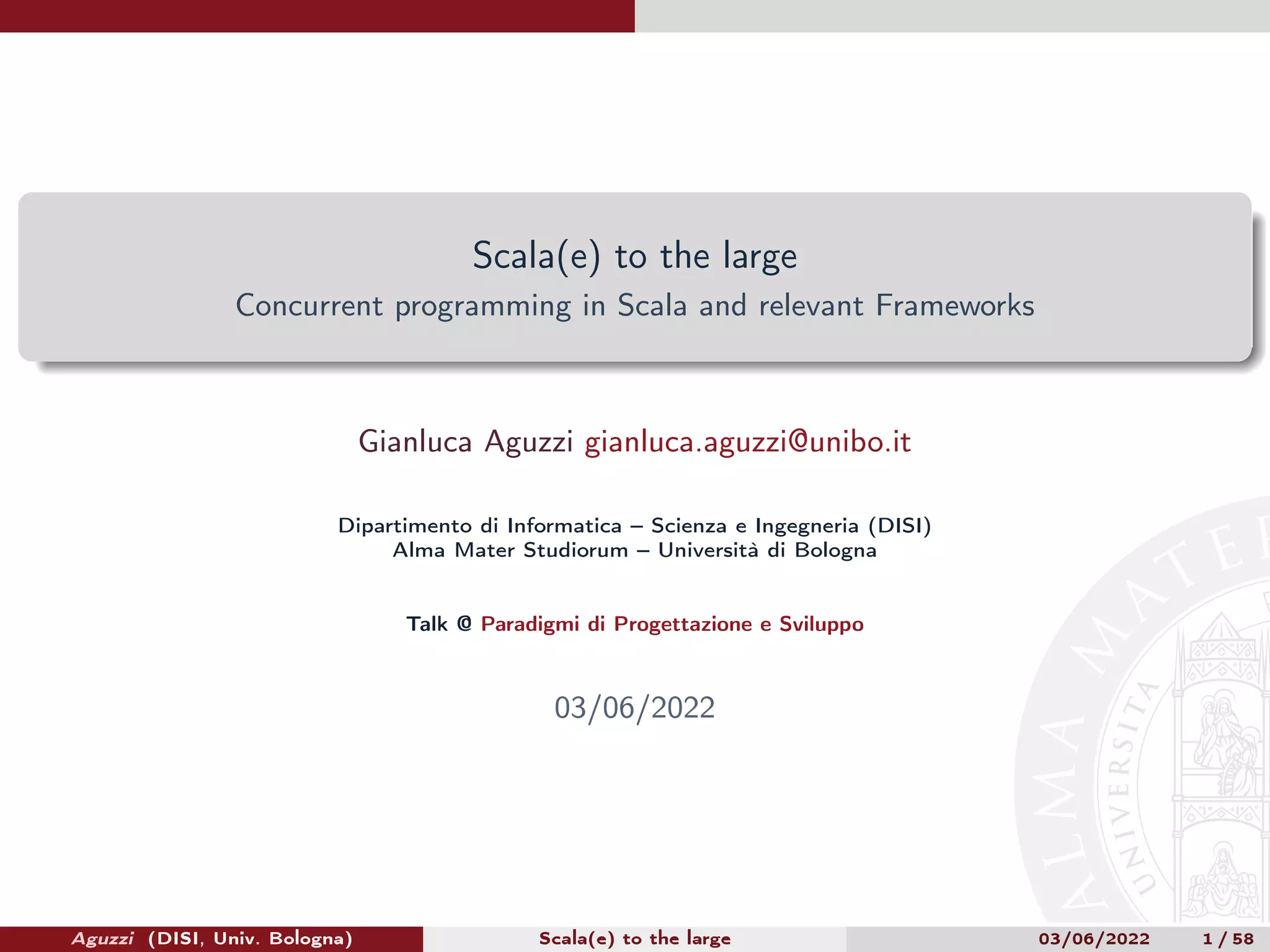
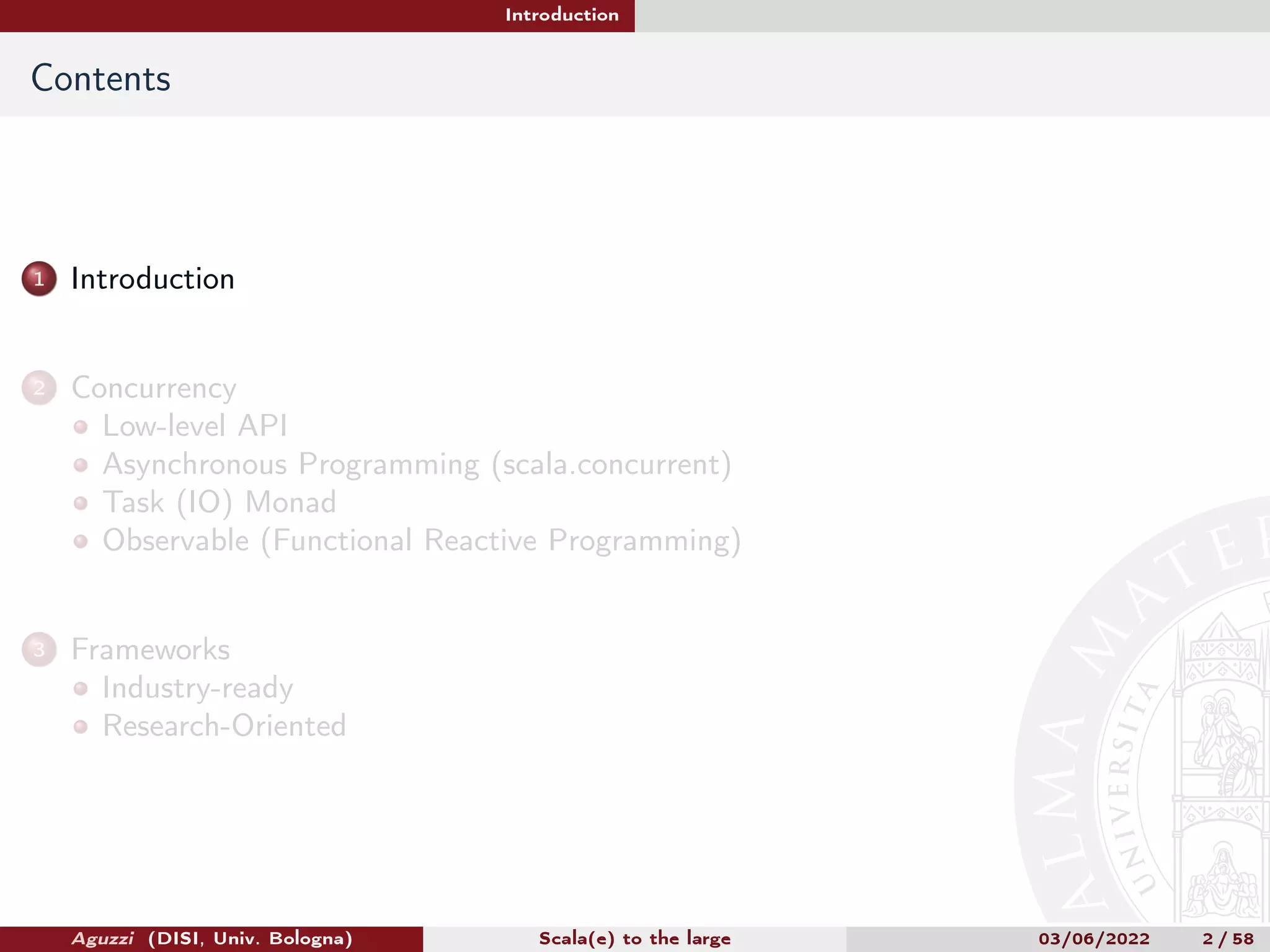
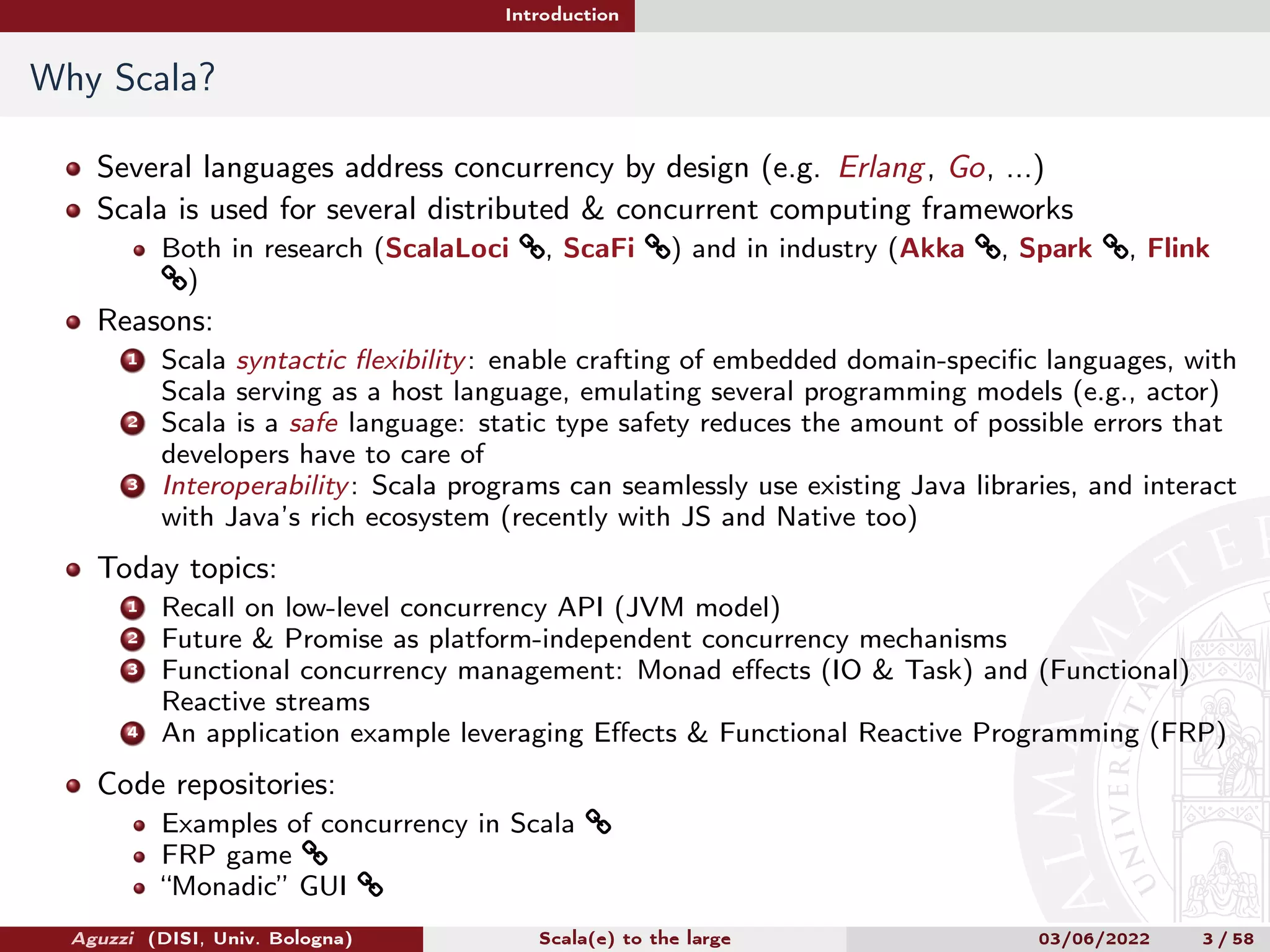
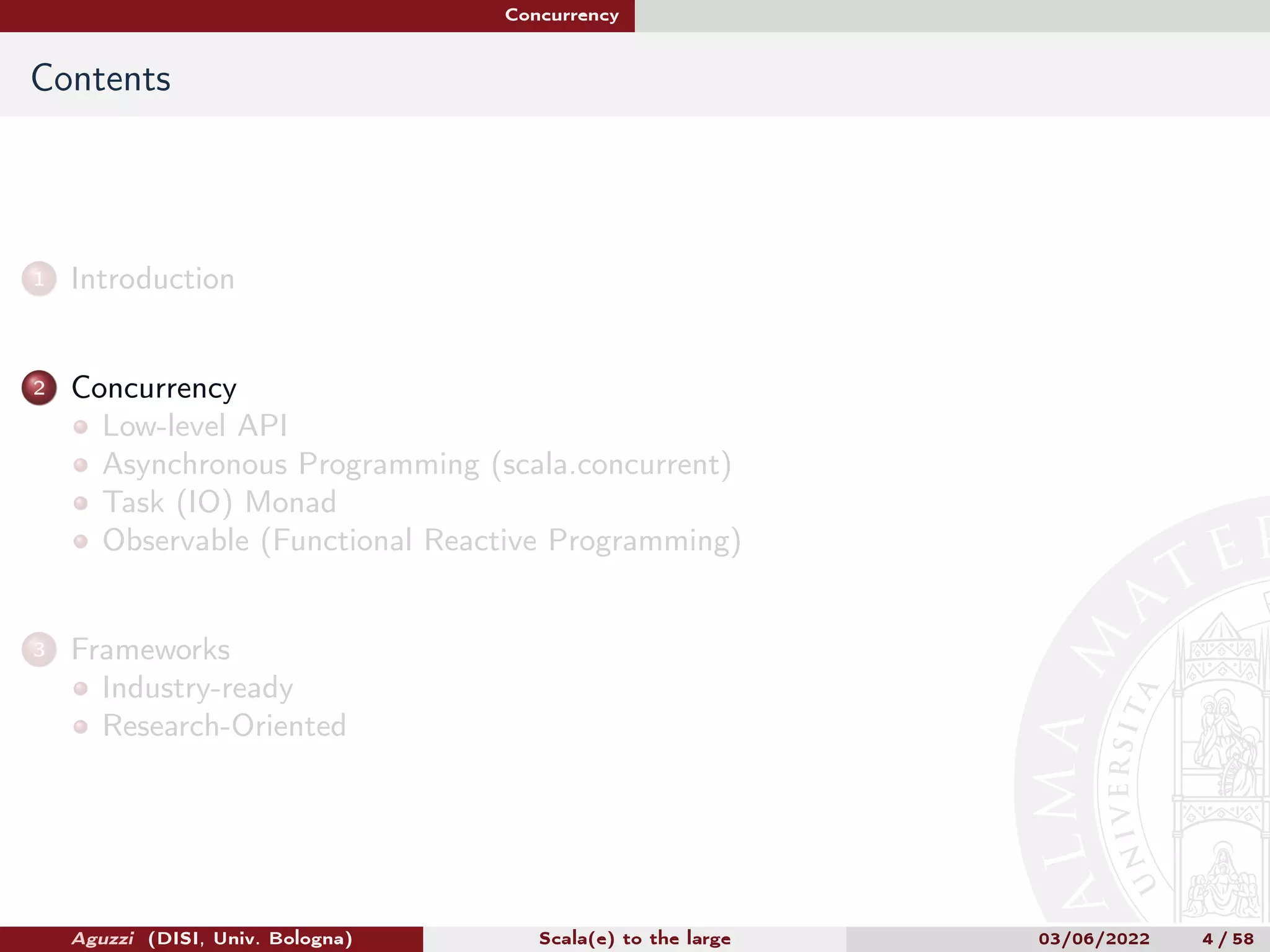



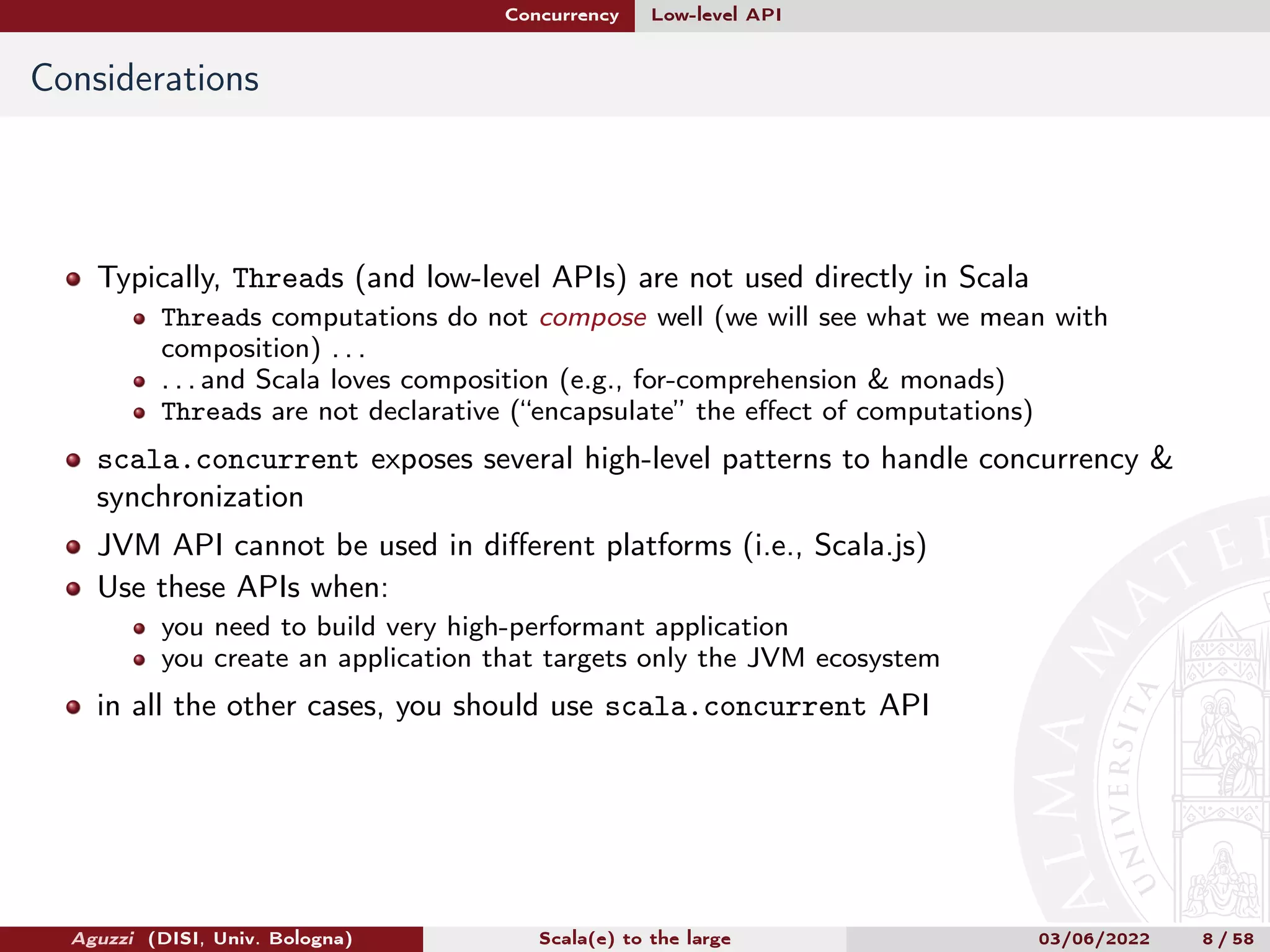
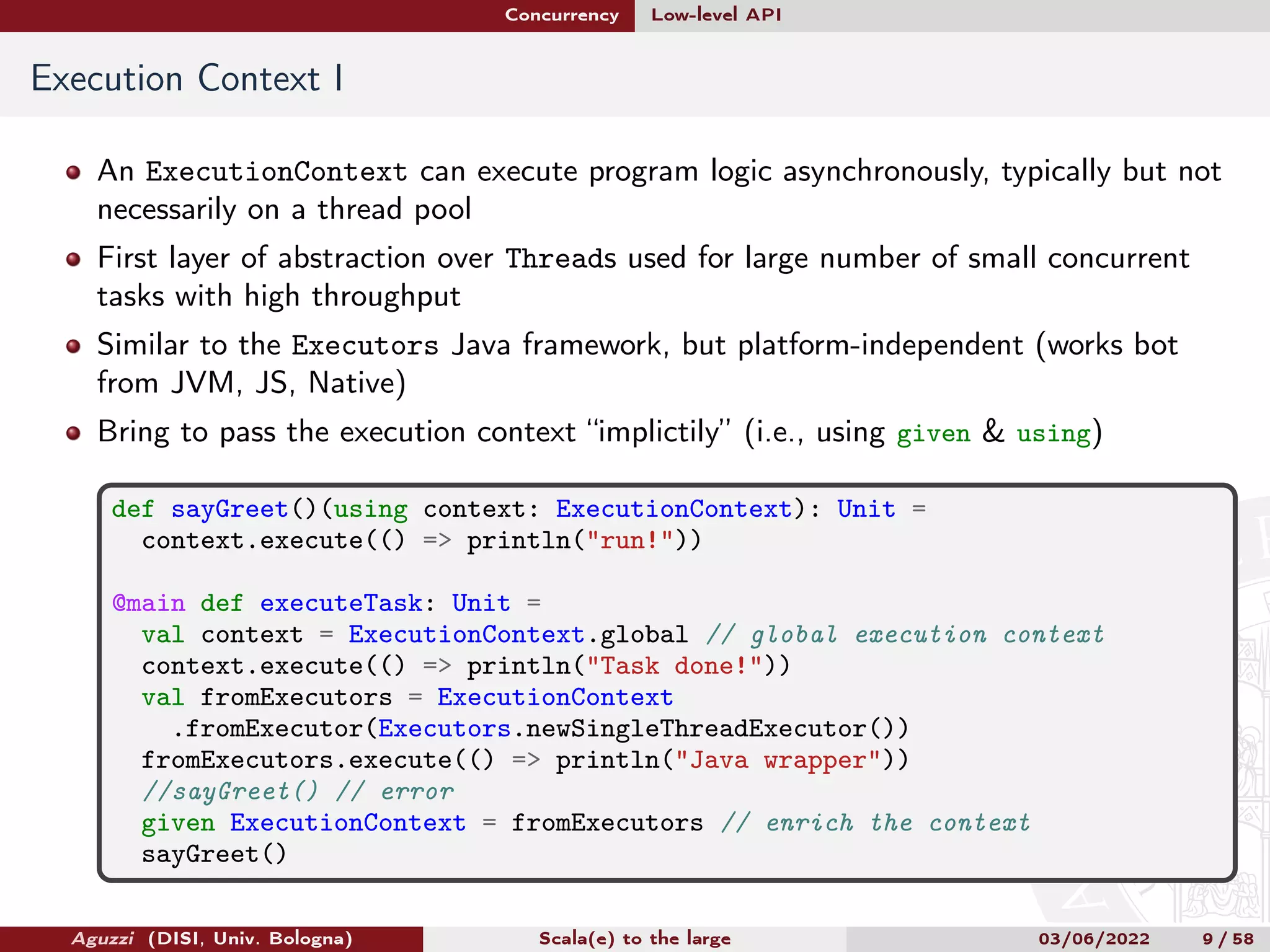
![Concurrency Low-level API Execution Context II Used as an “execution” context platform for high level concurrent abstraction (e.g., Future) We can built a “context”-oriented DSL for async computation: /* In Scala, a natural way to "enrich" the new "language" consists in using contexts + entrypoints. */ def async(any: => Unit)(using ExecutionContext): Unit = summon[ExecutionContext].execute(() => any) @main def tryDsl(): Unit = // express the context ==> enrich the language given ExecutionContext = ExecutionContext.global println("Do somethings") async { // I can use async like a language API println("order??") } println("After") Aguzzi (DISI, Univ. Bologna) Scala(e) to the large 03/06/2022 10 / 58](https://image.slidesharecdn.com/scala-to-the-large-220921084504-42ce61ab/75/Scala-e-to-the-large-Concurrent-programming-in-Scala-and-relevant-Frameworks-10-2048.jpg)
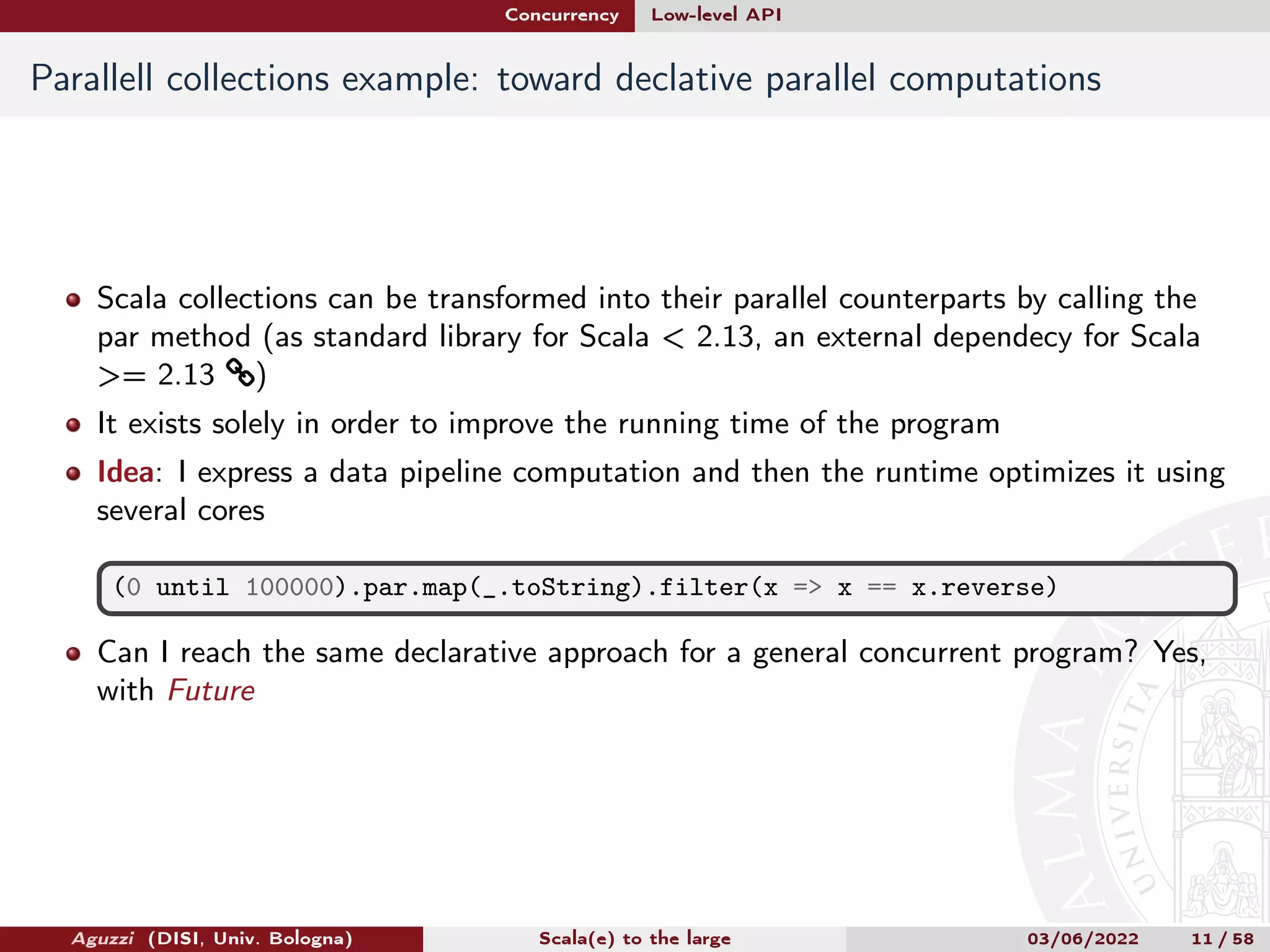
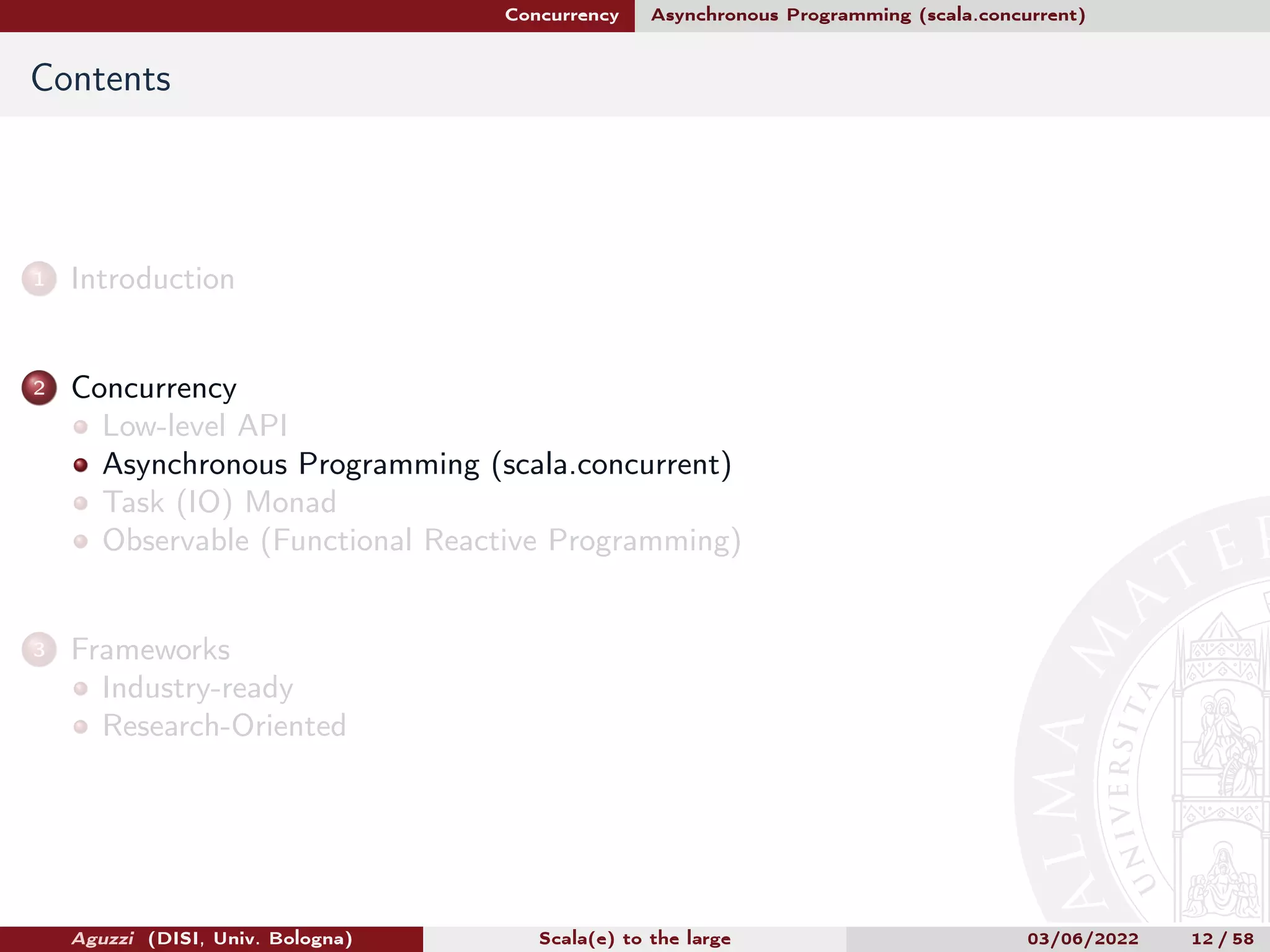
![Concurrency Asynchronous Programming (scala.concurrent) Future Definition “A Future represents a value which may or may not currently be available, but will be available at some point, or as an exception if that value could not be made available.” It is the idiomatic way to express concurrent computations You can handle the result of a Future with callback and transformation methods Future is a monad that models latency as an effect Futures are one-shot: the value contained by a future will be eventually available Futures are eager: the computation starts on Future creation Futures memoize the value: once the computation is over, the data will be always the same Examples: HTTP requests, File writing & reading, TCP connections, ... On notation A future value: trait Future[T] A future computation is an asynchronous computation that produces a future value: def something[T](...)(using ExecutionContext): Future[T] Aguzzi (DISI, Univ. Bologna) Scala(e) to the large 03/06/2022 13 / 58](https://image.slidesharecdn.com/scala-to-the-large-220921084504-42ce61ab/75/Scala-e-to-the-large-Concurrent-programming-in-Scala-and-relevant-Frameworks-13-2048.jpg)
![Concurrency Asynchronous Programming (scala.concurrent) Future API I Future Creation // To create a future computation, you have to enrich the context using ExecutionContext = scala.concurrent.ExecutionContext.global Future { 1 } // Future are eager, i.e., the computation starts on creation val fututers = (1 to 10).map(Future.apply) // create sequence of future // standard Monad sequence, applied to Future :) Future.sequential(futures) // Map F[Future[_]] in Future[F[_]] Future Callbacks Future(10) .onComplete { case Success(value) => println(s"Hurray! $value") case Failure(exception) => println("Oh no..") } Aguzzi (DISI, Univ. Bologna) Scala(e) to the large 03/06/2022 14 / 58](https://image.slidesharecdn.com/scala-to-the-large-220921084504-42ce61ab/75/Scala-e-to-the-large-Concurrent-programming-in-Scala-and-relevant-Frameworks-14-2048.jpg)

![Concurrency Asynchronous Programming (scala.concurrent) Future API III For Comprehension def extractLines(source: Source): String = source.getLines().mkString("n") def readFile(name: String): Future[Source] = Future { Source.fromFile(name) } val concurrentManipulation = for { buildSbt <- readFile("build.sbt") // synchornization point, scalafmt has to wait buildSbt future // NB! these two futures are sequential scalafmt <- readFile(".scalafmt.conf") // I can map the "lazy" data inside a Future "for-comprehension".. fileSbt = extractLines(buildSbt) fileFmt = extractLines(scalafmt) } yield (fileFmt + fileSbt) Aguzzi (DISI, Univ. Bologna) Scala(e) to the large 03/06/2022 16 / 58](https://image.slidesharecdn.com/scala-to-the-large-220921084504-42ce61ab/75/Scala-e-to-the-large-Concurrent-programming-in-Scala-and-relevant-Frameworks-16-2048.jpg)
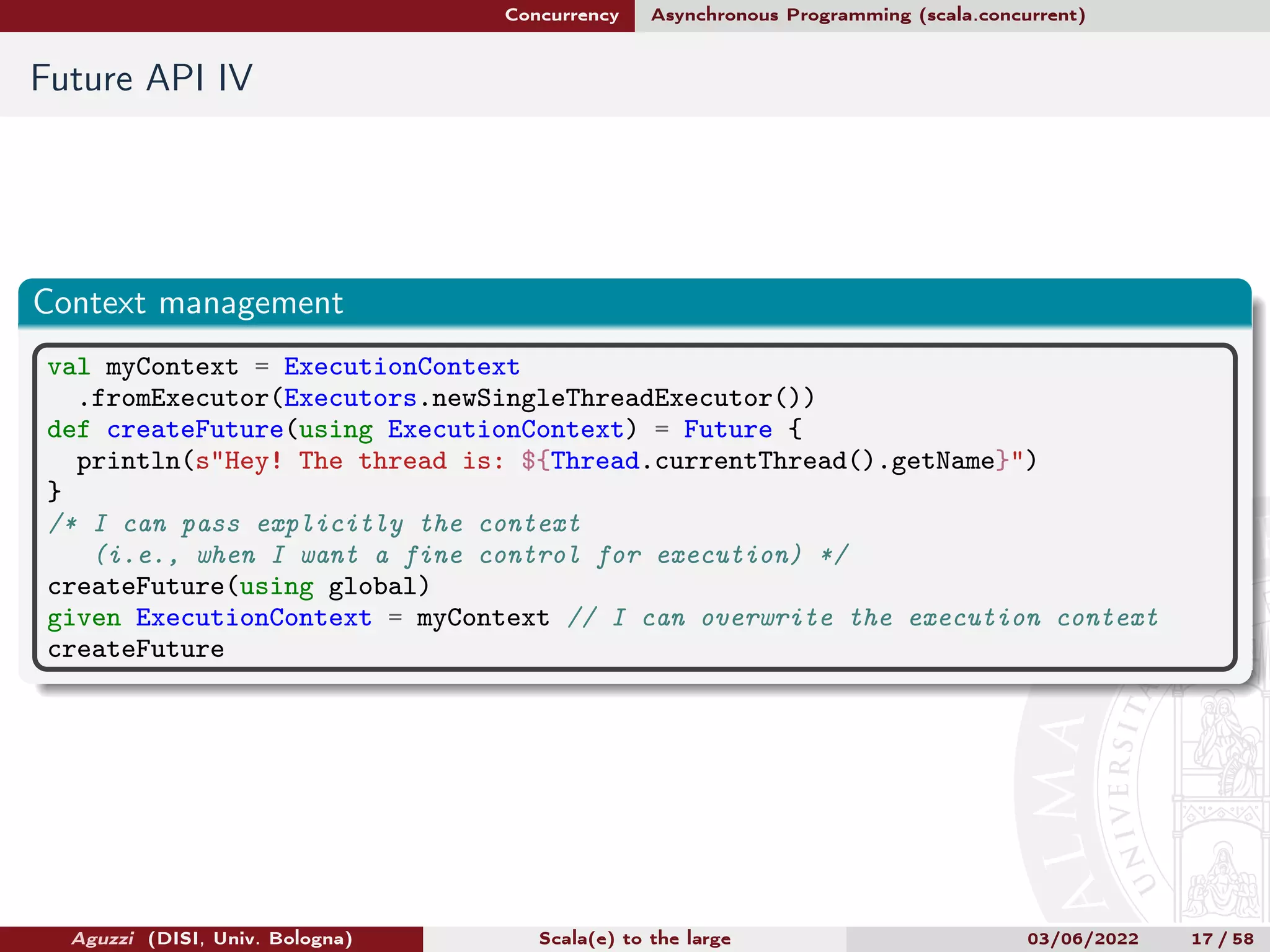
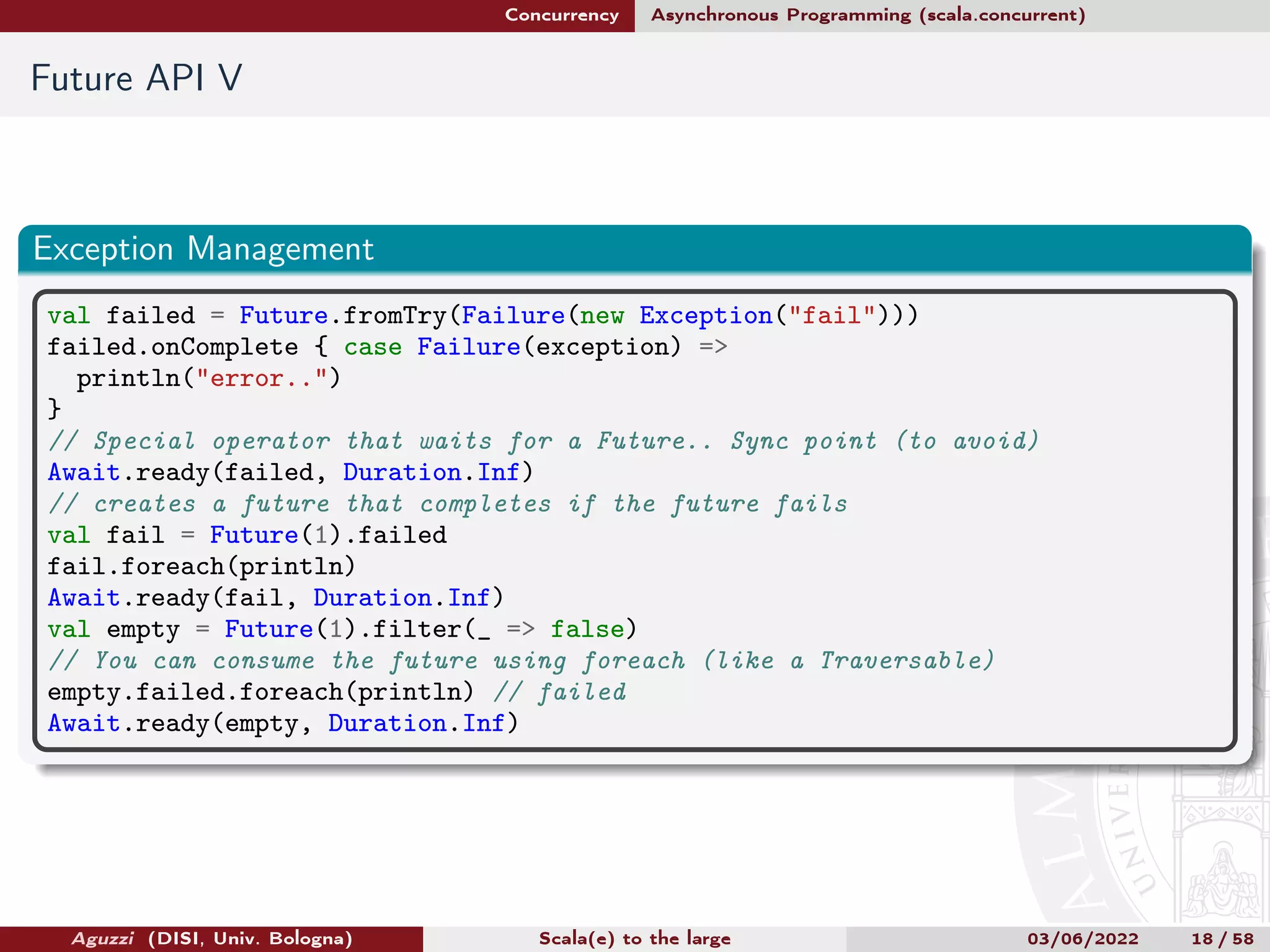
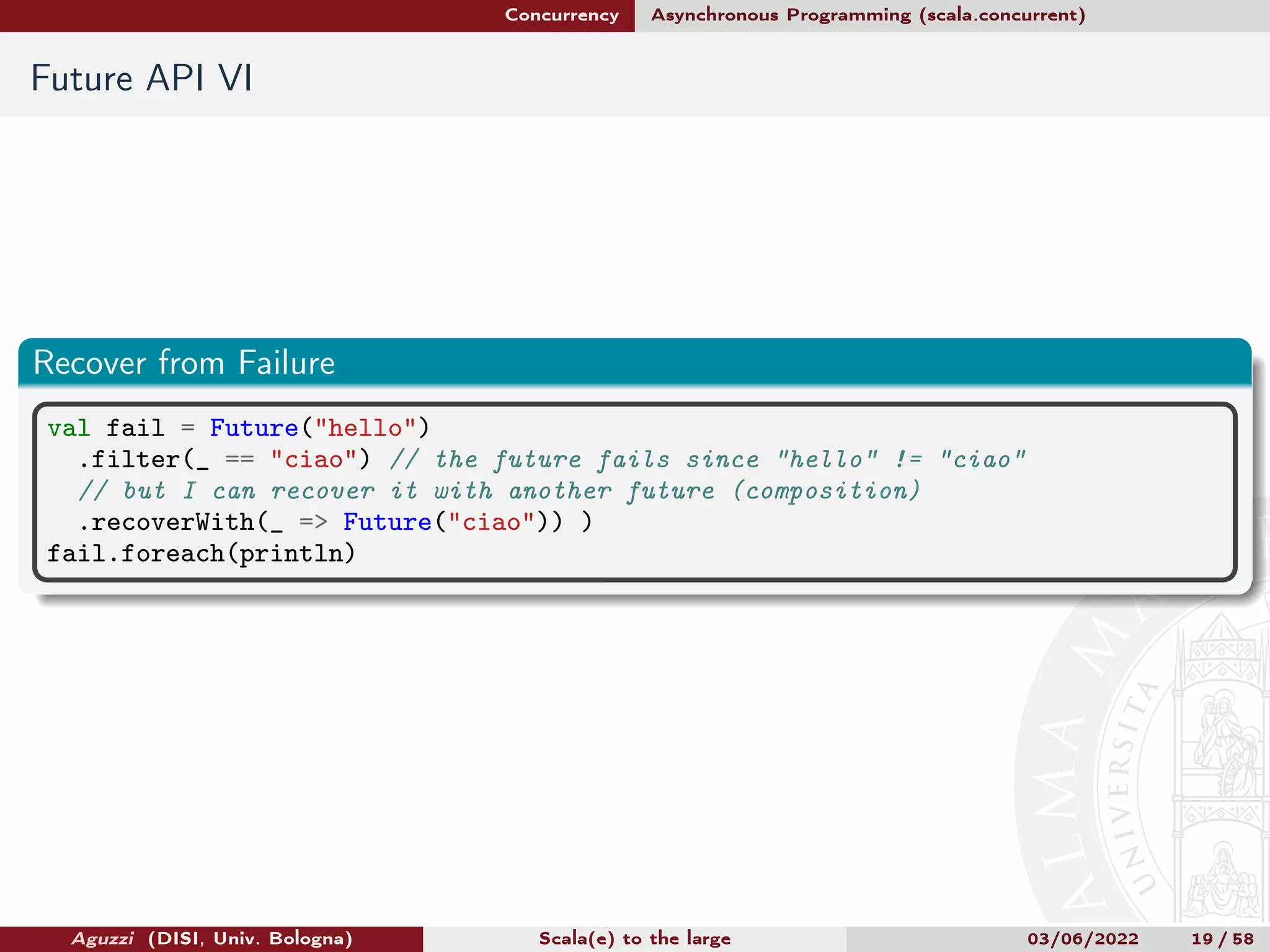
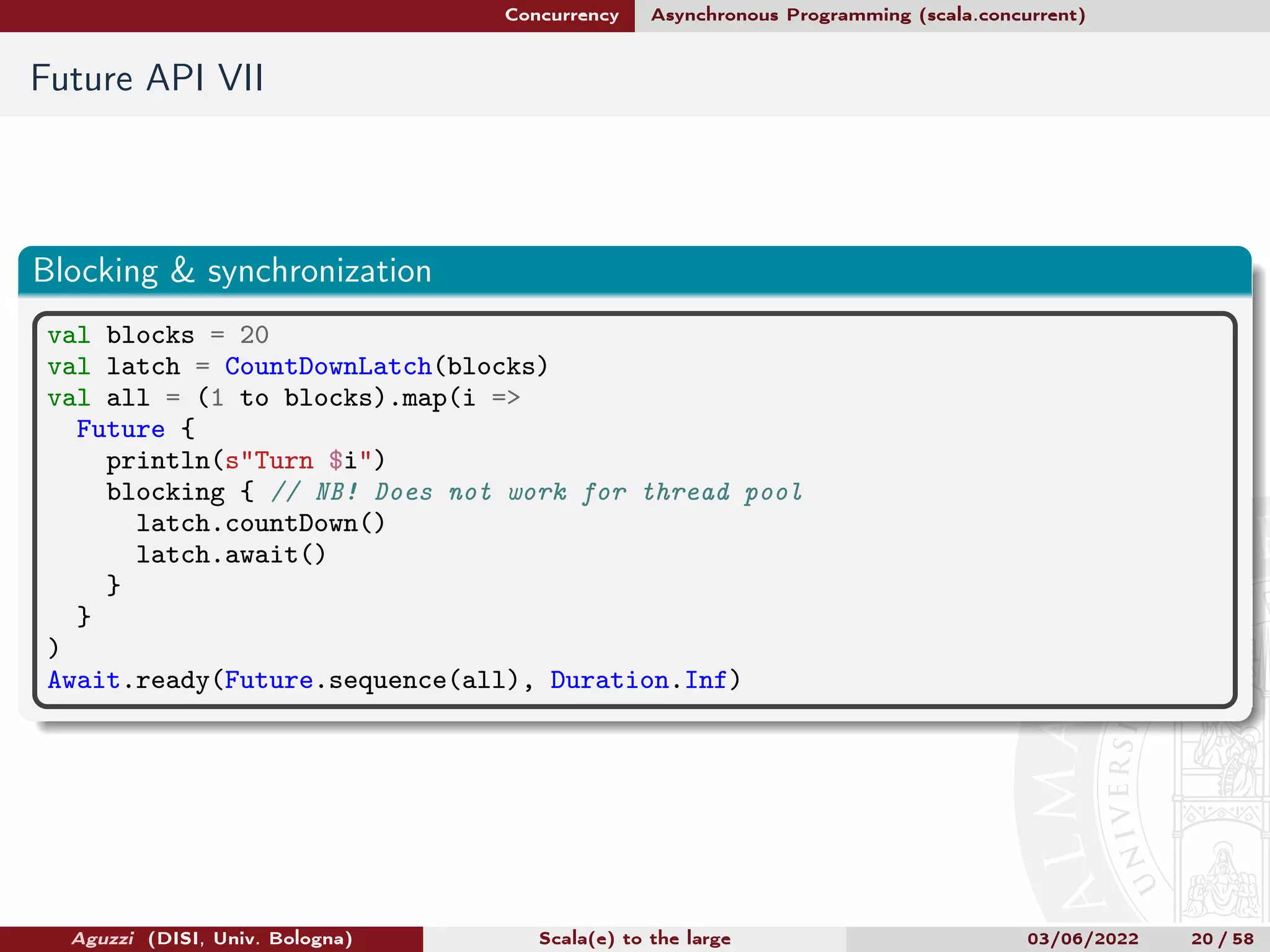
![Concurrency Asynchronous Programming (scala.concurrent) Promise A Factory of Future A Promise can be thought of as a writable, single-assignment container, which completes a future Single assignment means that the Promise can be completed once (both with a value or with an exception) Use promises to bridge the gap between callback-based APIs and futures Use promises to extend futures with additional functional combinators Promise API: in a nutshell val promise = Promise[Int]() // Promise created.. promise.future.foreach(println) // "interface" to read the value promise.success(10) // Everything ok!! try promise.success(10) // Exception!! catch case ex: IllegalStateException => println("Already completed!!") Aguzzi (DISI, Univ. Bologna) Scala(e) to the large 03/06/2022 21 / 58](https://image.slidesharecdn.com/scala-to-the-large-220921084504-42ce61ab/75/Scala-e-to-the-large-Concurrent-programming-in-Scala-and-relevant-Frameworks-21-2048.jpg)
![Concurrency Asynchronous Programming (scala.concurrent) Future Consideration about FP Futures are eager ú we cannot express lazy computation Future { println("Start!!") } // the computation starts on creation Futures are memoized ú we cannot restart a computation that brings to a certain value val result = Future { math.random } result.foreach { println(_) } result.foreach { pritnln(_) } // same result! Futures are not referential transparent ú we cannot build pure FP programs val random = Random(0) def future(random: Random): Future[Int] = Future { random.nextInt(10) } for a <- future(random); b <- future(random) yield (a + b) // !== val futureRandom = future(Random(0)) for a <- futureRandom; b <- futureRandom yield (a + b) Futures combine the execution and the computation Aguzzi (DISI, Univ. Bologna) Scala(e) to the large 03/06/2022 22 / 58](https://image.slidesharecdn.com/scala-to-the-large-220921084504-42ce61ab/75/Scala-e-to-the-large-Concurrent-programming-in-Scala-and-relevant-Frameworks-22-2048.jpg)
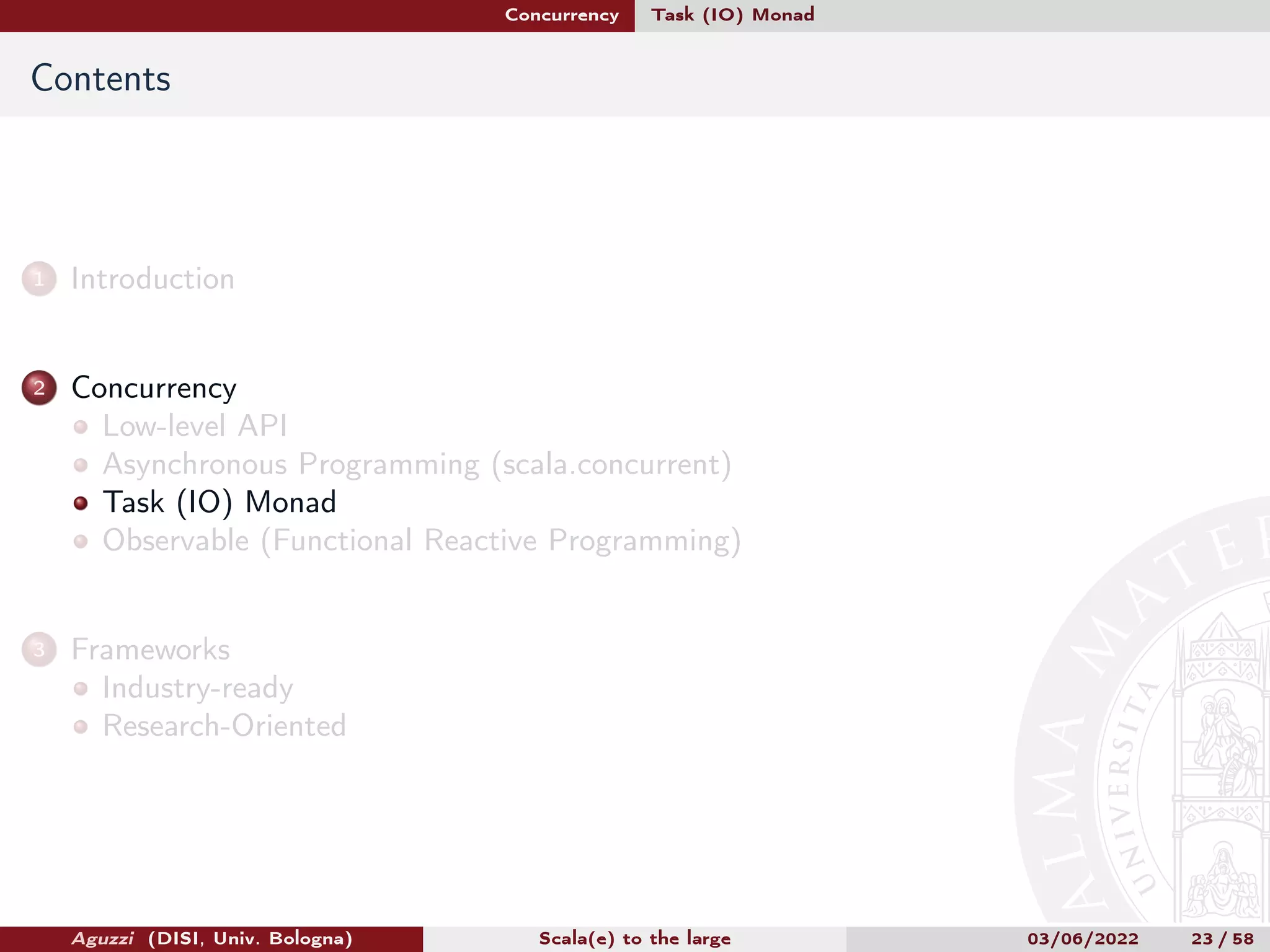
![Concurrency Task (IO) Monad Effects (in FP) An effect is a description of an action (or actions) that will be taken when evaluation happens In Category Theory term, each Monad has an effect Option is a monad that models the effect of optionality (of being something optional) Future is a monad that models the impact of latency IO (in Cats ® term, Task in Monix ®) is a monad that models the effect of computation Therefore, effects 6= side-effects when a piece of code contains (express with effect) a side-effect, that action just happens IO (and Task, we will use this name hereafter) can be executed asynchronously, in parallel, in different threads, ... NB! When side-effecting code is wrapped in one Task... ... the code itself still contains side-effects but we can reason about the whole thing as an effect, rather than as a side-effect // this has a side-effect, // but I can reason about this computation as Task[String] Task { Source.fromFile(...) } NB! IO is more general then Task, but today we consider these abstractions as the same Aguzzi (DISI, Univ. Bologna) Scala(e) to the large 03/06/2022 24 / 58](https://image.slidesharecdn.com/scala-to-the-large-220921084504-42ce61ab/75/Scala-e-to-the-large-Concurrent-programming-in-Scala-and-relevant-Frameworks-24-2048.jpg)


![Concurrency Task (IO) Monad Task API II Task Manipulation val file = Task(Source.fromFile("build.sbt")) def linesFromSource(source: Source): Task[List[String]] = Task(source.getLines().toList).map(_.take(5)) // Sequence evaluation val result = for { build <- file lines <- linesFromSource(build) } yield lines.mkString("n") Aguzzi (DISI, Univ. Bologna) Scala(e) to the large 03/06/2022 27 / 58](https://image.slidesharecdn.com/scala-to-the-large-220921084504-42ce61ab/75/Scala-e-to-the-large-Concurrent-programming-in-Scala-and-relevant-Frameworks-27-2048.jpg)
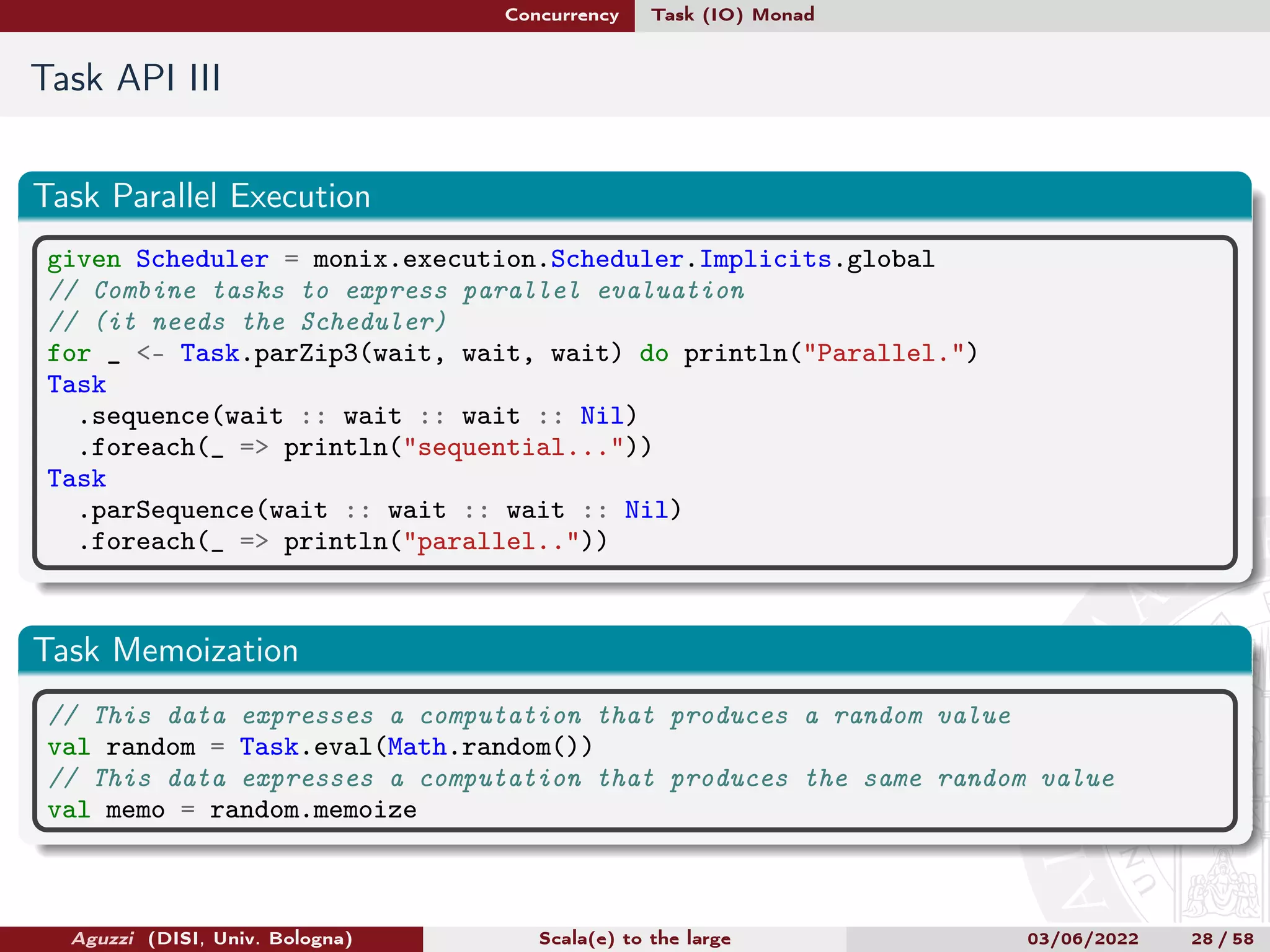
 // like a Lock // Just an example, indeed you should not use vars... // Consider shared resources (e.g. a file)... var shared = 0 def effect: Task[Unit] = Task { shared += 1 println(Thread.currentThread().getName) } val syncComputation = for { synch <- semaphore tasks = (1 to 1000).map(_ => synch.withPermit(effect)) par <- Task.parSequence(tasks) } yield par syncComputation.runSyncUnsafe() assert(shared == 1000) Aguzzi (DISI, Univ. Bologna) Scala(e) to the large 03/06/2022 29 / 58](https://image.slidesharecdn.com/scala-to-the-large-220921084504-42ce61ab/75/Scala-e-to-the-large-Concurrent-programming-in-Scala-and-relevant-Frameworks-29-2048.jpg)
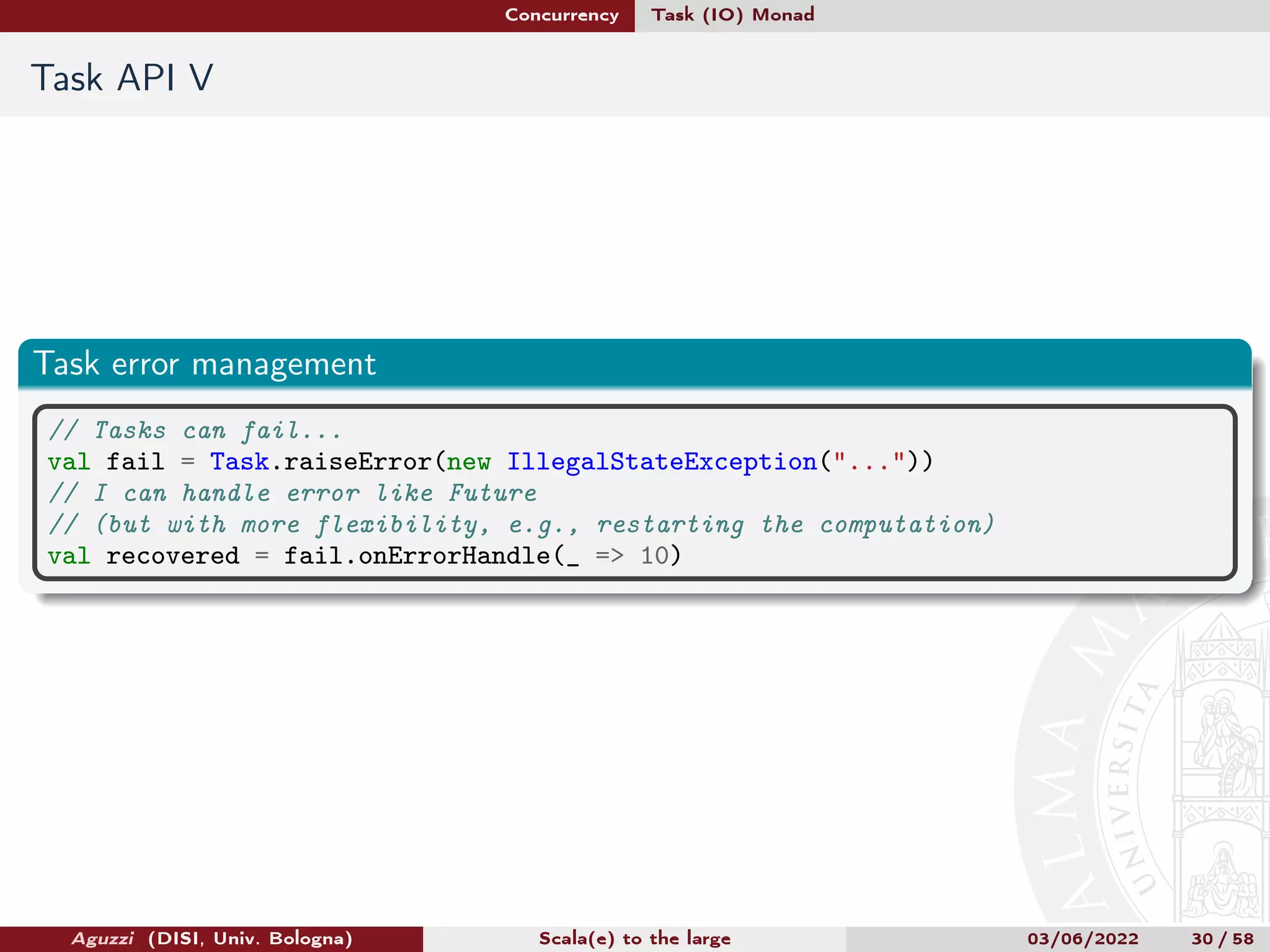
![Concurrency Task (IO) Monad Task API VI An Entire application expressed with Task enum State: case Continue, End val input = Task.eval(StdIn.readLine()) val hello = Task.evalOnce(println("Hello!! welcome to this beautiful game!!")) lazy val parse: Task[Int] = input .map(_.toInt) .onErrorHandleWith(_ => Task(println("Insert a number!!")) .flatMap(_ => parse) ) val toGuess = Task.evalOnce(Random.nextInt(10)) val toHigh = Task(println("The number is wrong!! (high)")).map(_ => State.Continue) val toLow = Task(println("The number is wrong!! (low)")).map(_ => State.Continue) val correct = Task(println("You won!!")).map(_ => State.End) // The main, a typical way to express IO in functional program, through flatmap operations.. val game = for { _ <- hello number <- toGuess user <- parse state <- if (user < number) toLow else if (user > number) toHigh else correct } yield state Aguzzi (DISI, Univ. Bologna) Scala(e) to the large 03/06/2022 31 / 58](https://image.slidesharecdn.com/scala-to-the-large-220921084504-42ce61ab/75/Scala-e-to-the-large-Concurrent-programming-in-Scala-and-relevant-Frameworks-31-2048.jpg)

![Concurrency Observable (Functional Reactive Programming) Observable ® Definition The Observable is a data type for modeling and processing asynchronous and reactive streaming of (possibly infinite) events with non-blocking back-pressure. At its simplest, an Observable is a replacement for Iterable or Scala LazyList, but with the ability to process asynchronous events without blocking Enables Functional Reactive Programming (FRP) Basically the Observer pattern on steroids async events management (decoupling of control flow) backpressure error management Expresses lazy computations Inspired by ReacitveX ® Observable vs. Task Single Multiple Synchronous A Iterable[A] Asynchronous Future[A] / Task[A] Observable[A] Aguzzi (DISI, Univ. Bologna) Scala(e) to the large 03/06/2022 33 / 58](https://image.slidesharecdn.com/scala-to-the-large-220921084504-42ce61ab/75/Scala-e-to-the-large-Concurrent-programming-in-Scala-and-relevant-Frameworks-33-2048.jpg)
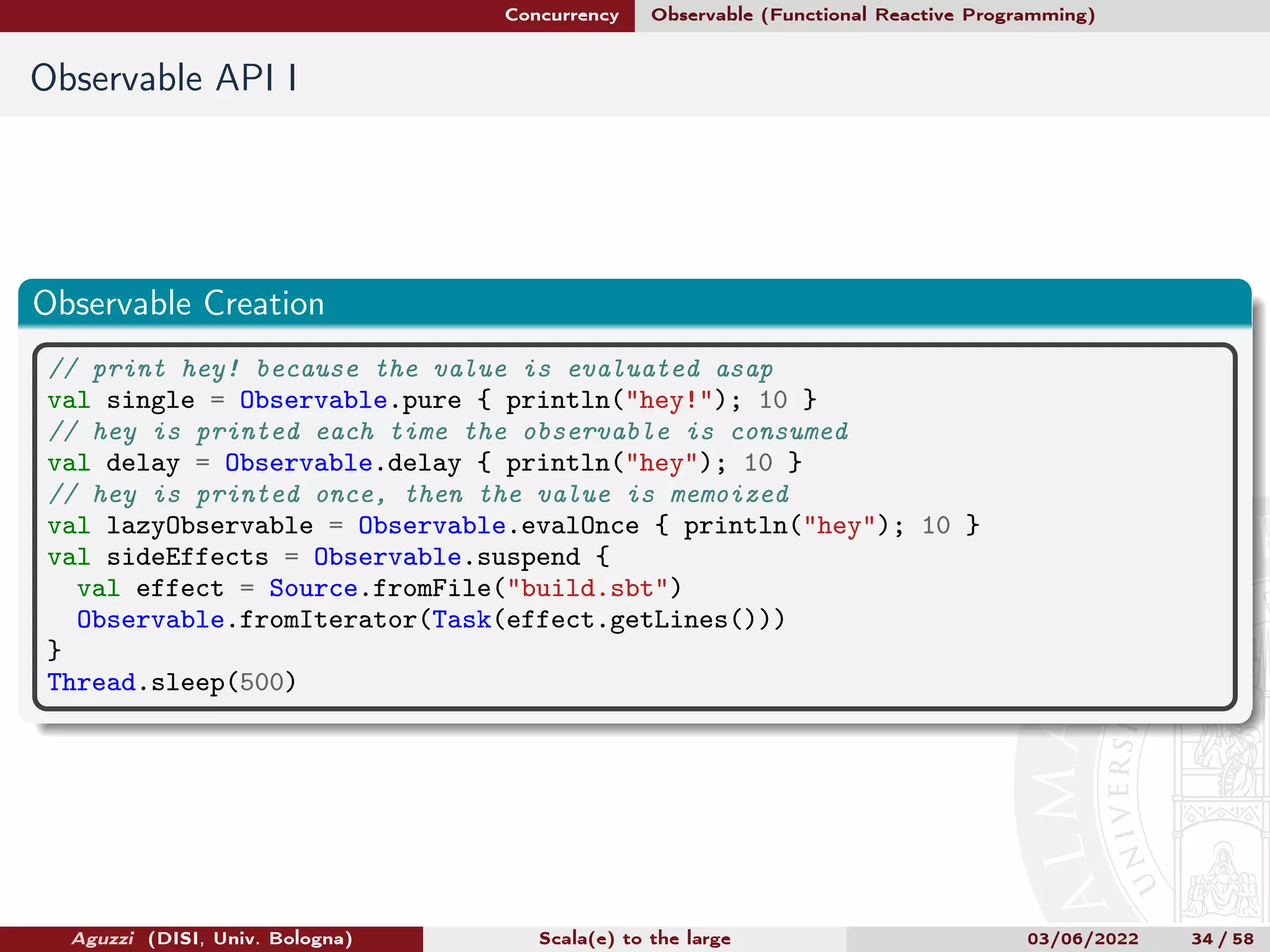

 { subject => button.addActionListener((e: ActionEvent) => subject.onNext(e.getWhen)) Cancelable.empty } // Or through subjects (i.e., tuple of observer and observable) val subject = ConcurrentSubject[Long](MulticastStrategy.replay) button.addActionListener((e: ActionEvent) => subject.onNext(e.getWhen)) Aguzzi (DISI, Univ. Bologna) Scala(e) to the large 03/06/2022 36 / 58](https://image.slidesharecdn.com/scala-to-the-large-220921084504-42ce61ab/75/Scala-e-to-the-large-Concurrent-programming-in-Scala-and-relevant-Frameworks-36-2048.jpg)
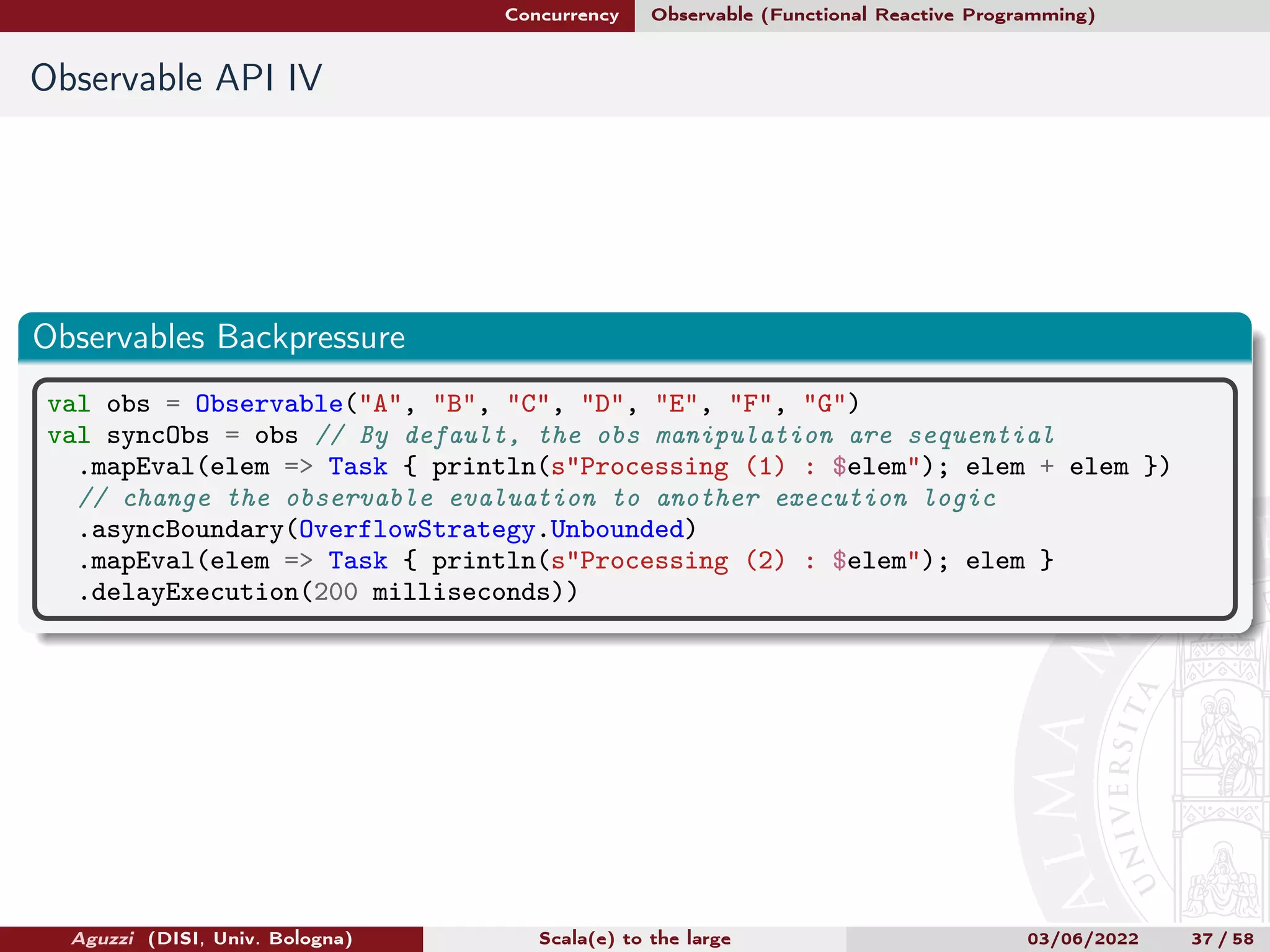
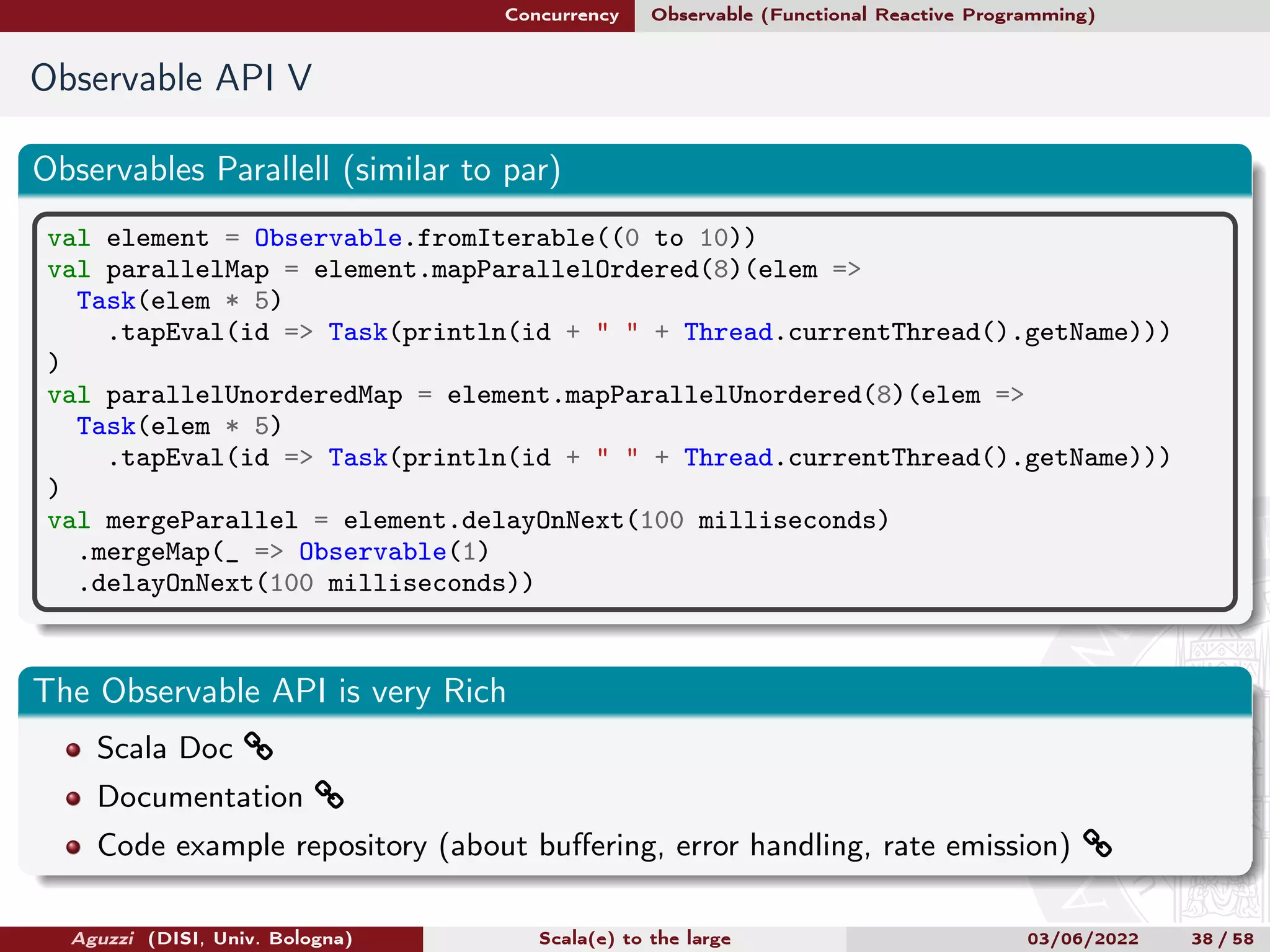
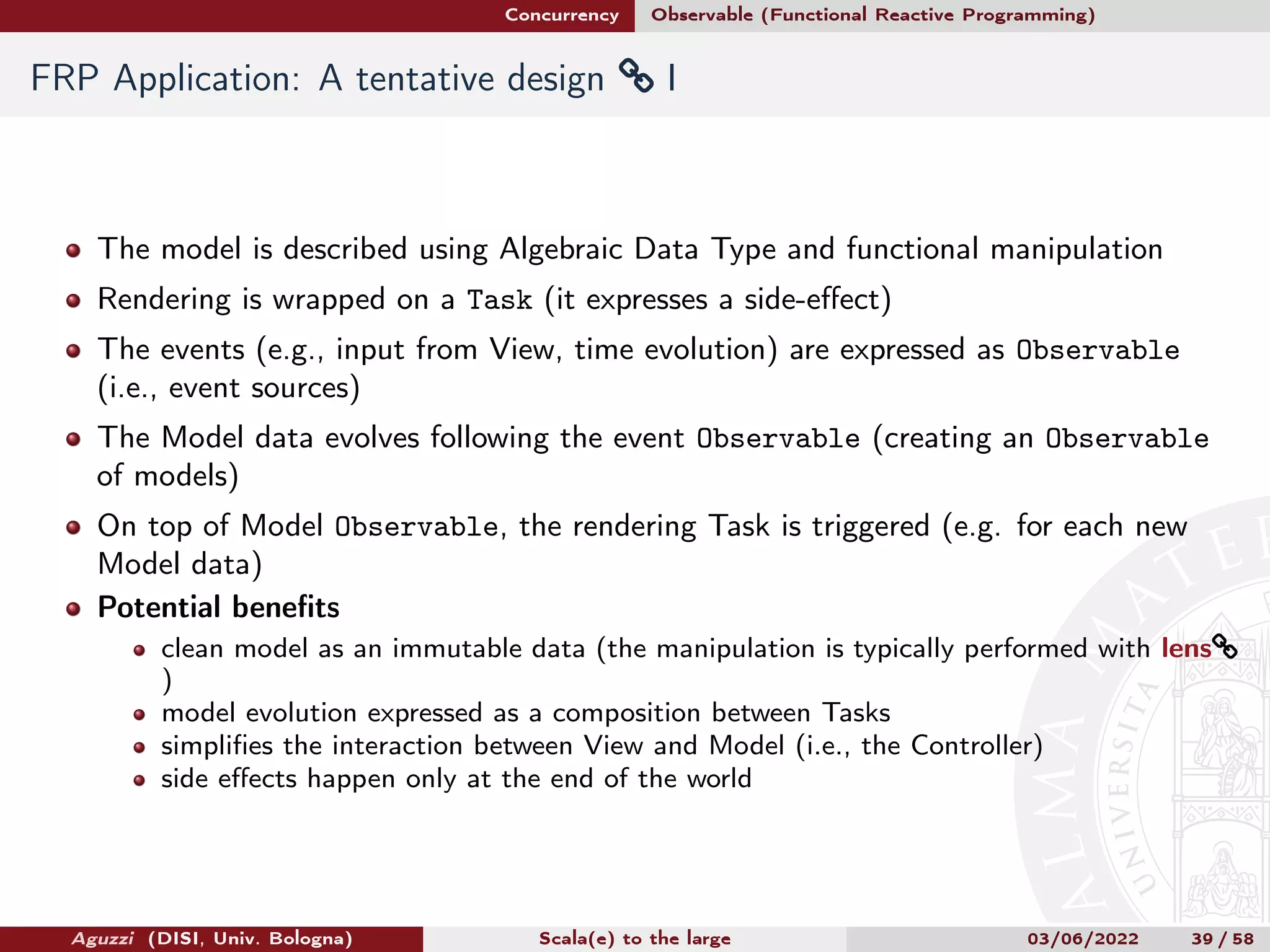
![Concurrency Observable (Functional Reactive Programming) FRP Application: A tentative design ® II UI (defines Input and Output boundary interface) // a general UI: trait UI[Event, Data] ==> it contains side effects!! //(but they are wrapper with monadic abstractions) // even more general: UI[Event, Data, F[_], R[_]] trait UI: // Event source produced by this UI // (outside of the "functional" world, unsafe, unpure) def events: Observable[Event] // Render the world representation. // It is an effect, therefore it returns a Task def render(world: World): Task[Unit] Model: set of data that expresses a snapshot of the "world" enum Entity(...): case Player(...), case class World(...) Aguzzi (DISI, Univ. Bologna) Scala(e) to the large 03/06/2022 40 / 58](https://image.slidesharecdn.com/scala-to-the-large-220921084504-42ce61ab/75/Scala-e-to-the-large-Concurrent-programming-in-Scala-and-relevant-Frameworks-40-2048.jpg)
![Concurrency Observable (Functional Reactive Programming) FRP Application: A tentative design ® III Update: namely how world should change // This should be expressed as a function, // (event, world) => Task[(Ager, Control)] // Or Controller[E, M, F[_]] => (E, M) => F[(M, Control[E, M, F])] trait Update extends ((Event, World) => Task[(World, Update)]): def andThen(control: Update): Update = ... // We cannot use type because it became a cyclic reference object Update: extension (function: (Event, World) => (World, Update)) def lift: Update = .. // Creation API def same(function: (Event, World) => World): Update = ... def on[E <: Event]( control: (E, World) => Task[World] )(using ev: ClassTag[E]): Update = ... def combineTwo(engineA: Update, engineB: Update): Update = ... def combine(engines: Update*): Update = ... Aguzzi (DISI, Univ. Bologna) Scala(e) to the large 03/06/2022 41 / 58](https://image.slidesharecdn.com/scala-to-the-large-220921084504-42ce61ab/75/Scala-e-to-the-large-Concurrent-programming-in-Scala-and-relevant-Frameworks-41-2048.jpg)
![Concurrency Observable (Functional Reactive Programming) FRP Application: A tentative design ® IV Main Loop def start(ui: UI): Task[Unit] = val time: Observable[Event] = TimeFlow // time progression .tickEach(33 milliseconds).map(_.toDouble).map(Event.TimePassed.apply) val world = World.empty // Initial condition of the game val controls: Update = ... // set of controls that update the world state // Initial "loop" condition, update and world can evolve with events val init = Task((world, controls)) val events = Observable(time, ui.events.throttleLast(33 milliseconds)).merge events // "Main" loop // World evolve following the event .scanEval(init) { case ((world, logic), event) => logic(event, world) } // For each frame, a rendering is requested .doOnNext { case (world, _) => ui.render(world) } .completedL // Compute until the game is over Aguzzi (DISI, Univ. Bologna) Scala(e) to the large 03/06/2022 42 / 58](https://image.slidesharecdn.com/scala-to-the-large-220921084504-42ce61ab/75/Scala-e-to-the-large-Concurrent-programming-in-Scala-and-relevant-Frameworks-42-2048.jpg)
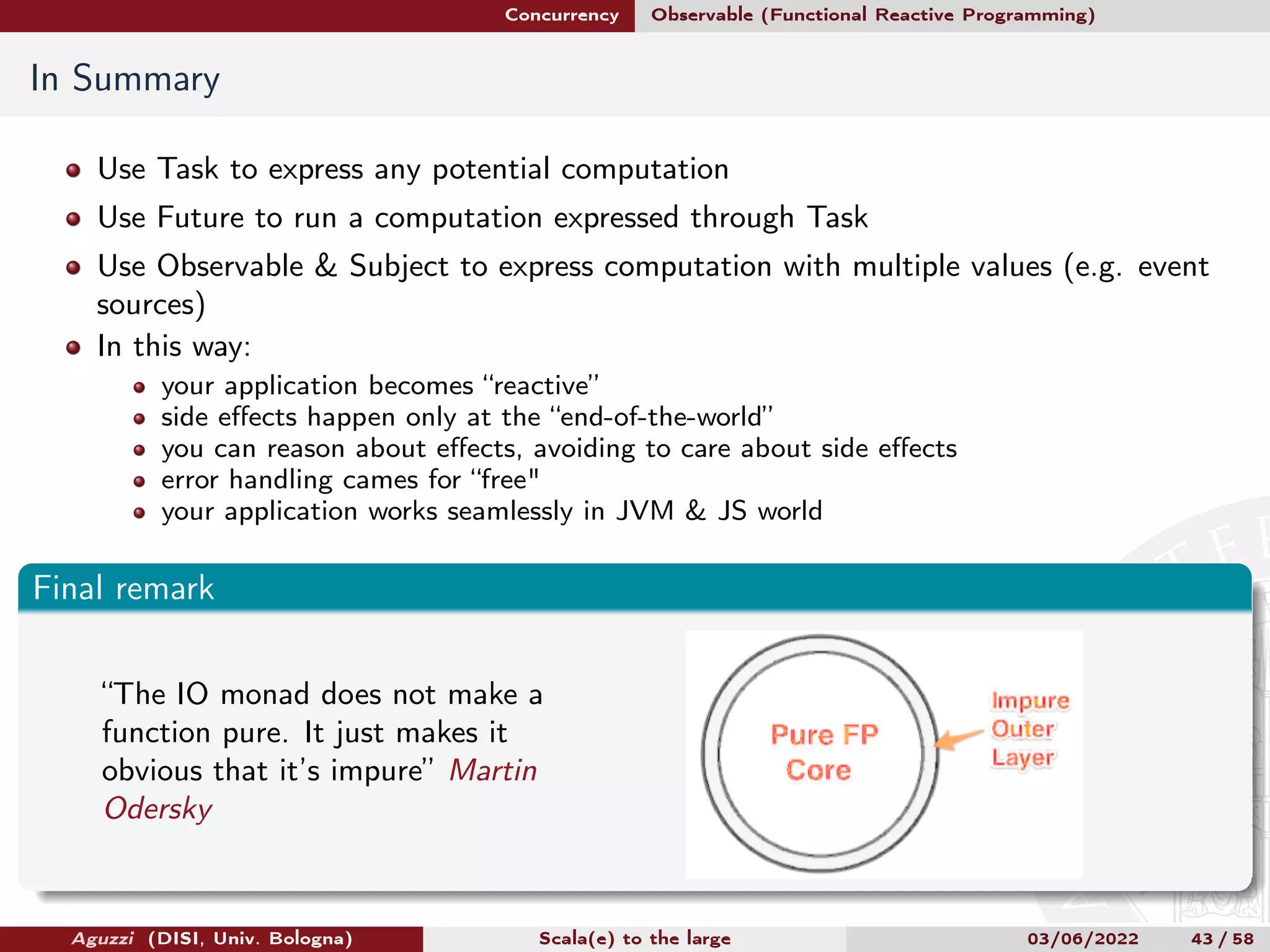
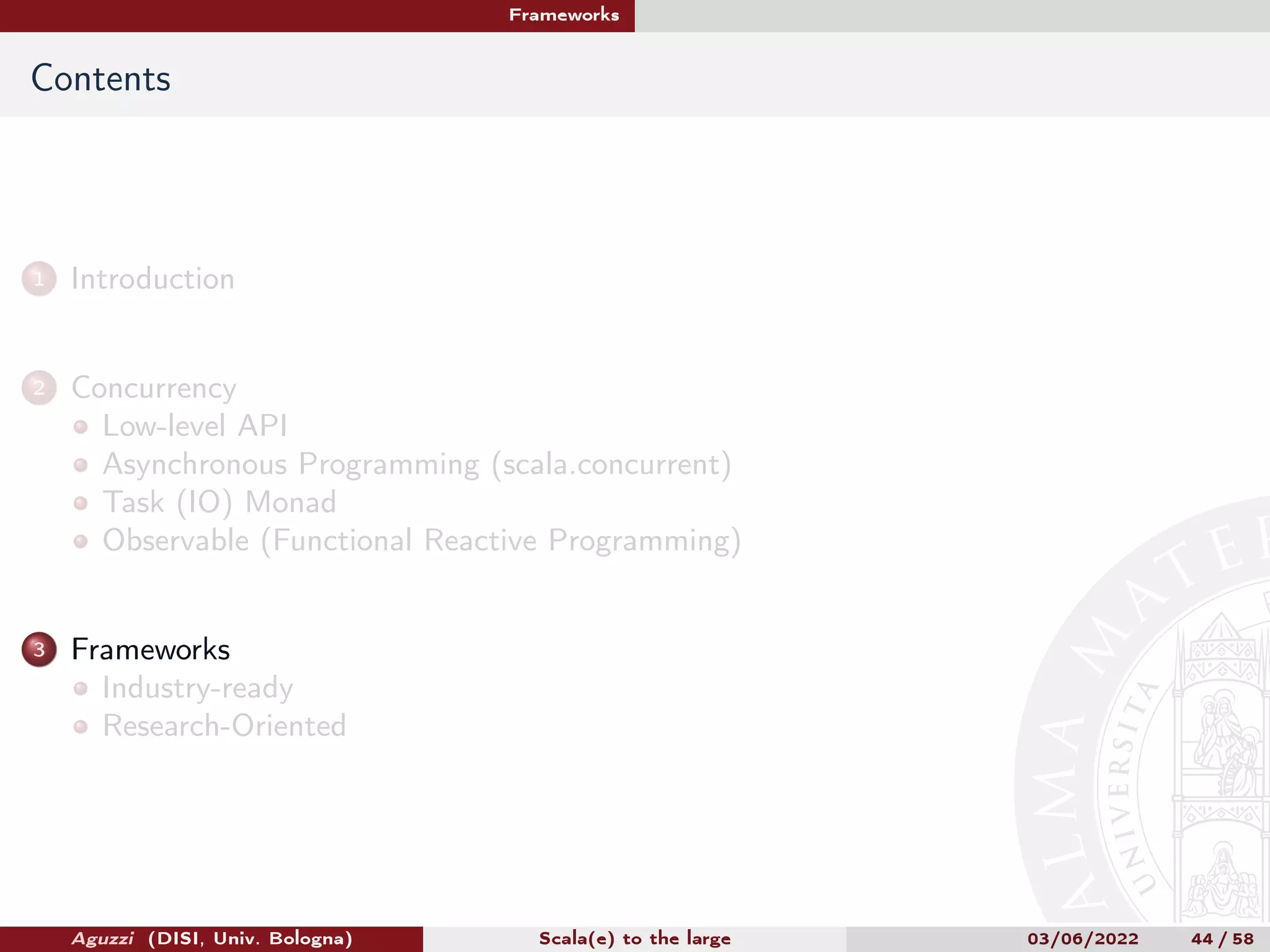
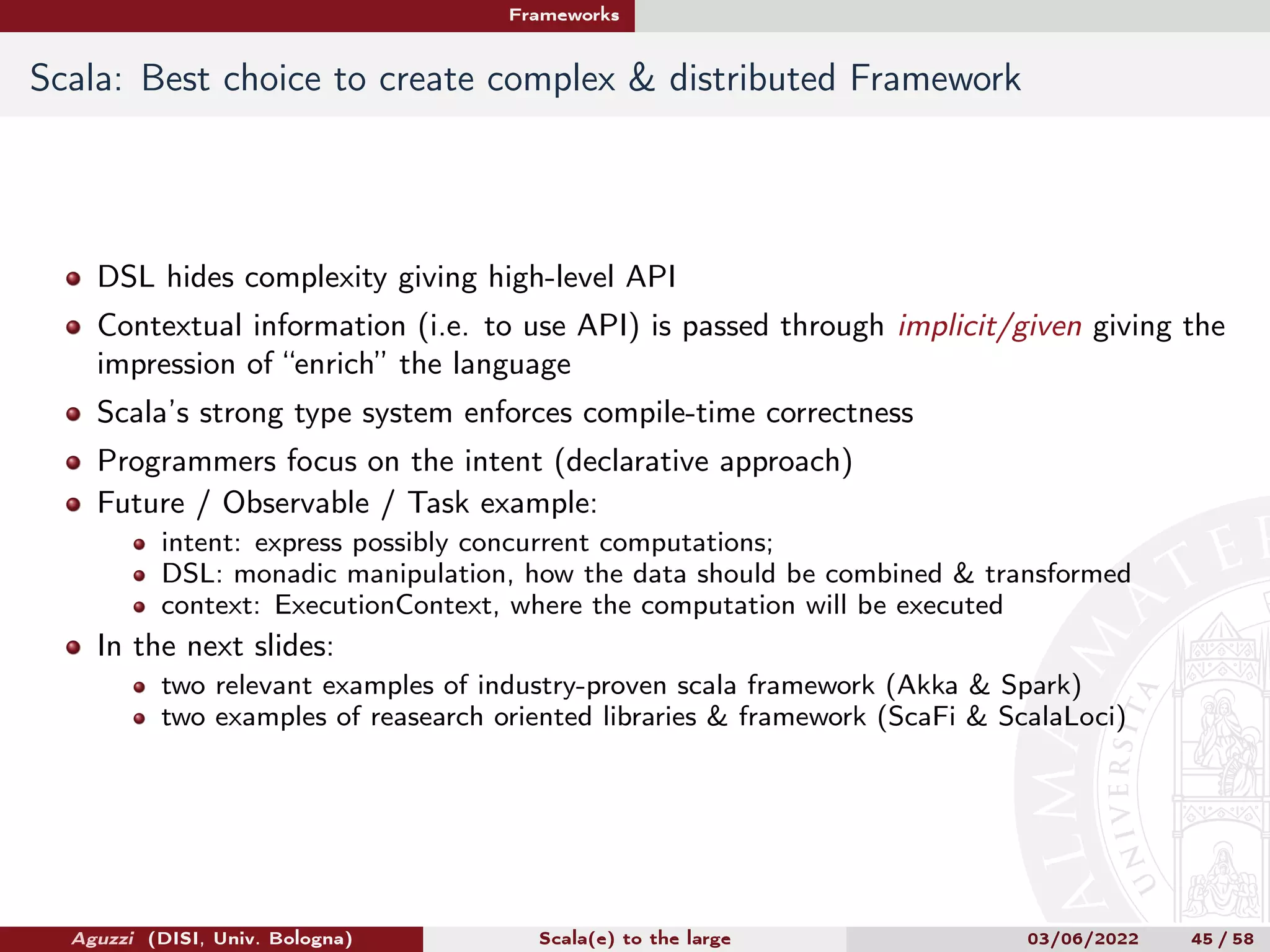





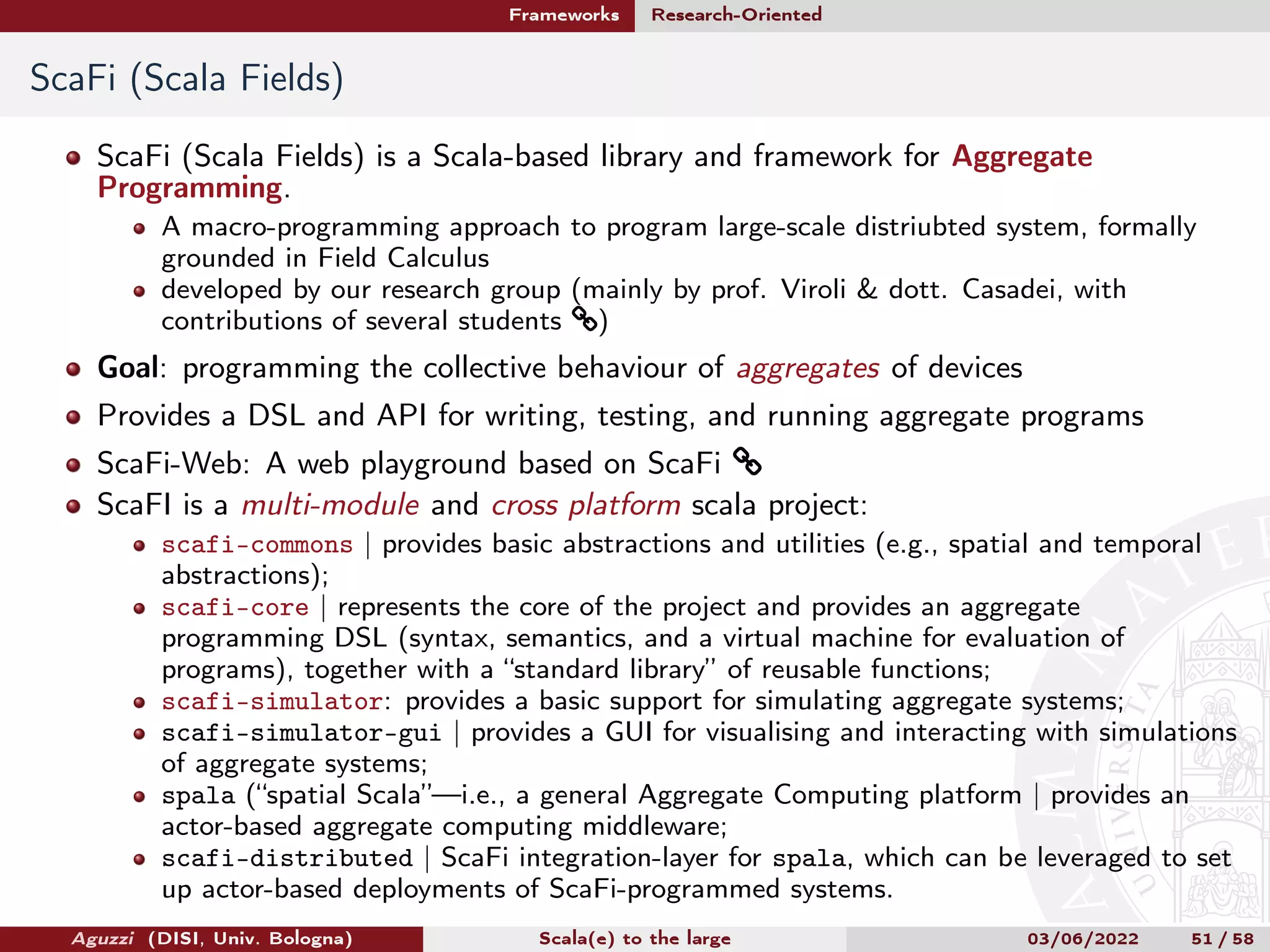
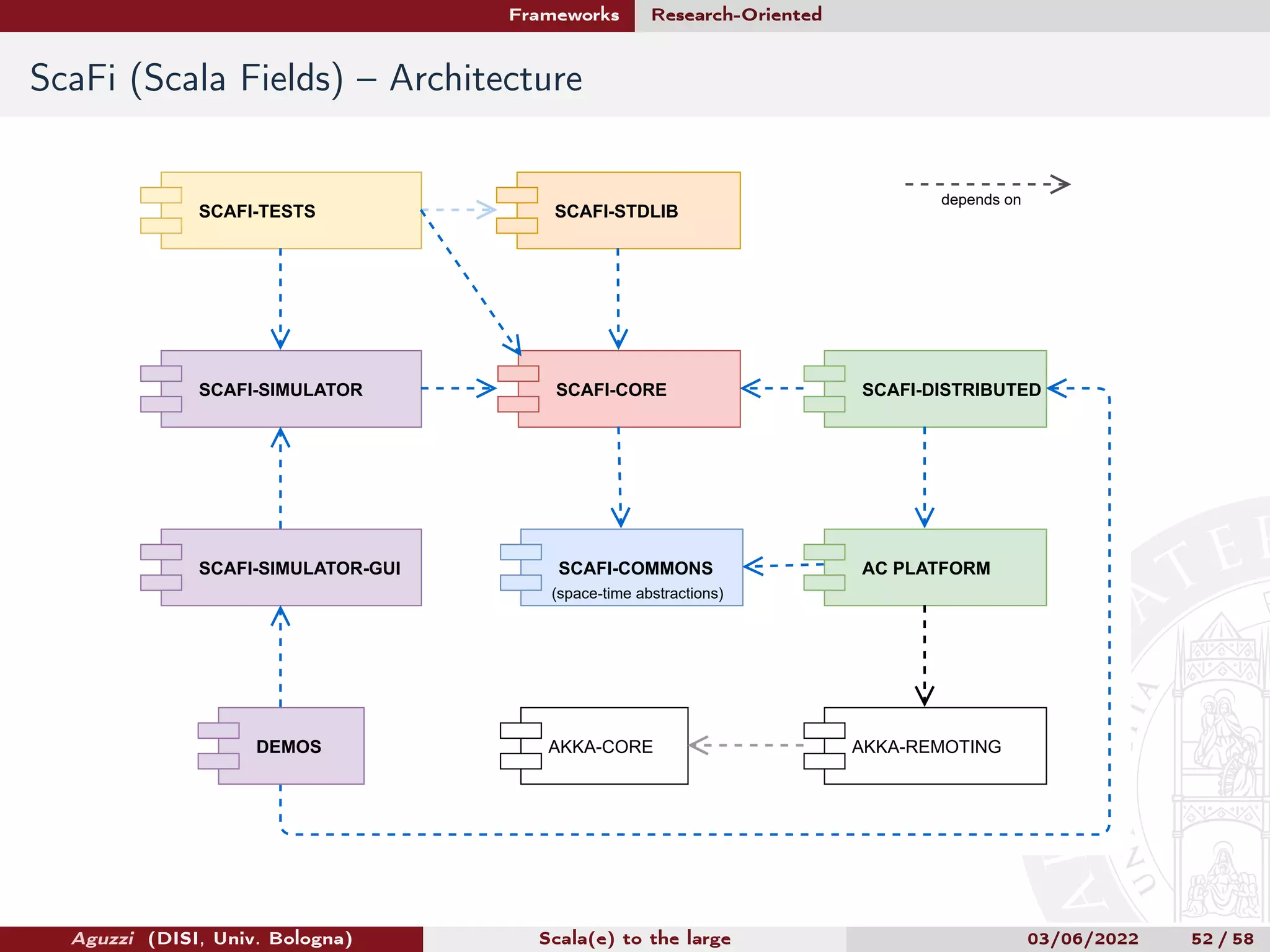

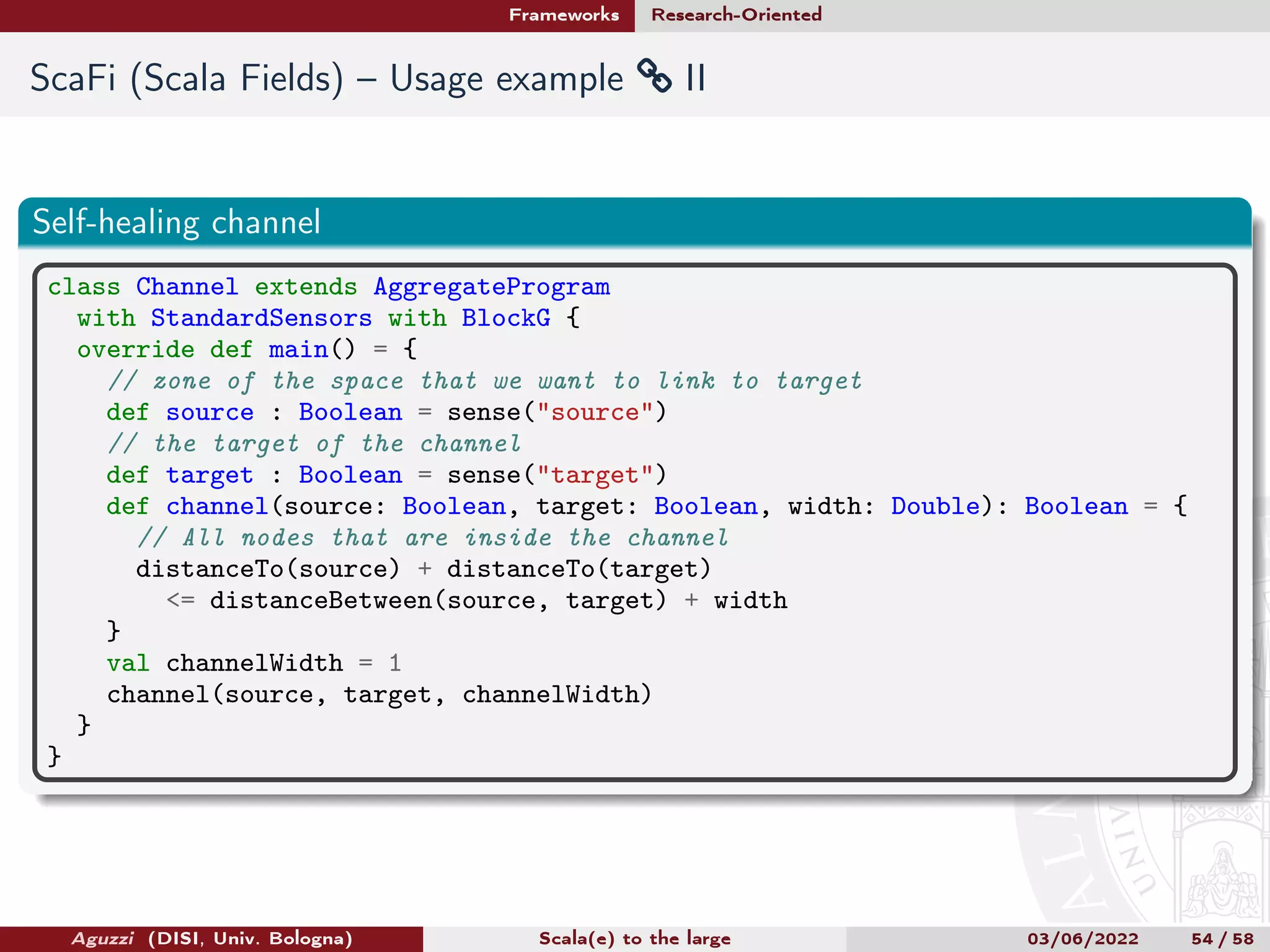

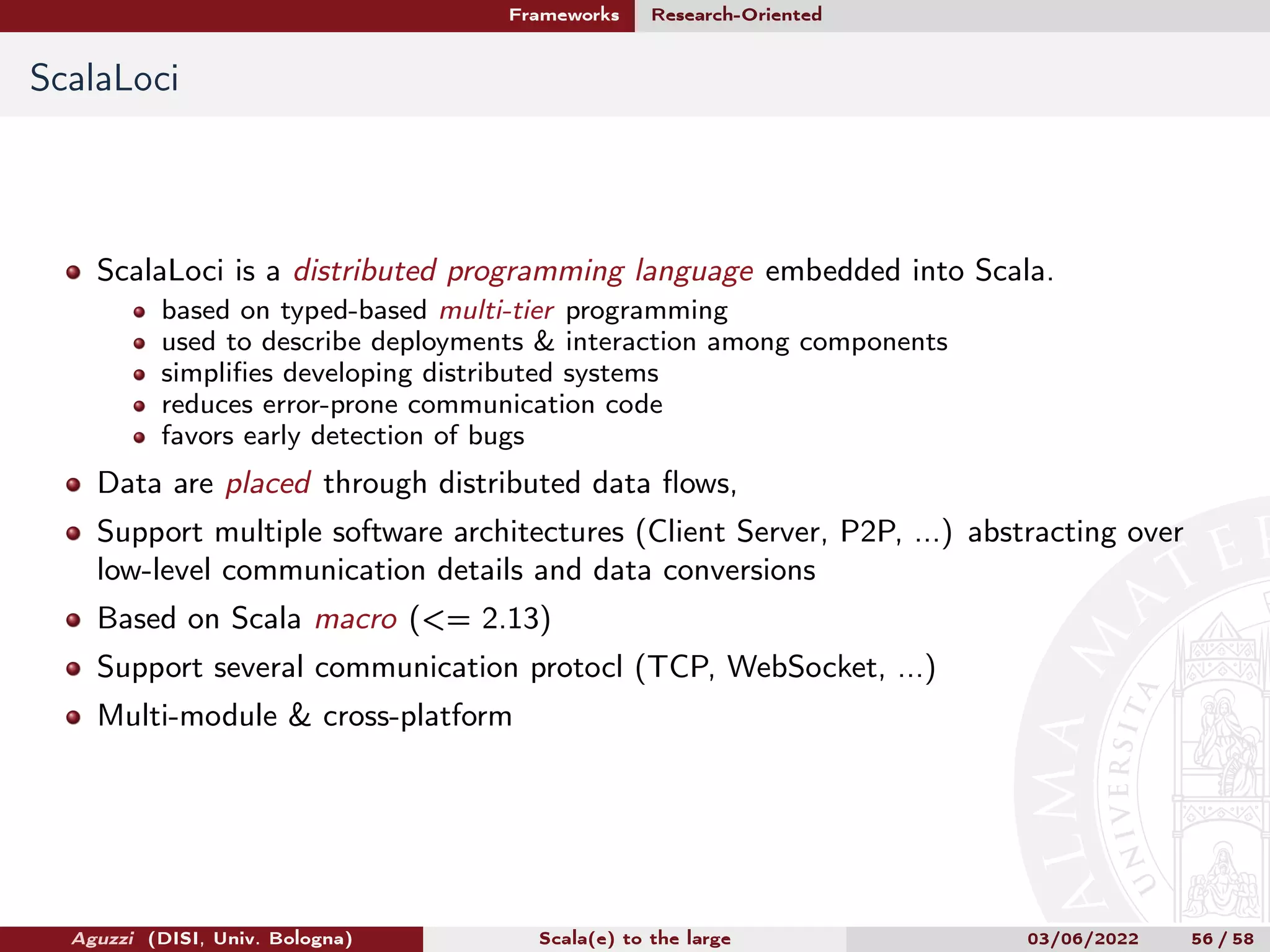
![Frameworks Research-Oriented ScalaLoci – Example import loci._ // Contexts.. import loci.serializer.upickle._ // Serialization context import loci.communicator.tcp._ // Communication context import rescala.default._ // Observable (reactive stream) cotenxt @multitier object Chat { // a deployment definition @peer type Server <: { type Tie <: Multiple[Client] } // peers and connections @peer type Client <: { type Tie <: Single[Server] } // Message are placed on Deployments val message : Evt[String] on Client = on[Client] { Evt[String] } // To access to remote data, I must have a Tie val publicMessage = on[Server] sbj { client: Remote[Client] => message.asLocalFromAllSeq collect { case (remote, message) if remote == client => message } } def main() = on[Client] { // Main client logic publicMessage.asLocal observe println for (line <- scala.io.Source.stdin.getLines) message.fire(line) } } // Elsewhere... object Server extends App { multitier start new Instance[Chat.Server](listen[Chat.Client] { TCP(43053) }) } object Client extends App { multitier start new Instance[Chat.Client](connect[Chat.Server] { TCP("localhost", 43053) }) } Aguzzi (DISI, Univ. Bologna) Scala(e) to the large 03/06/2022 57 / 58](https://image.slidesharecdn.com/scala-to-the-large-220921084504-42ce61ab/75/Scala-e-to-the-large-Concurrent-programming-in-Scala-and-relevant-Frameworks-57-2048.jpg)
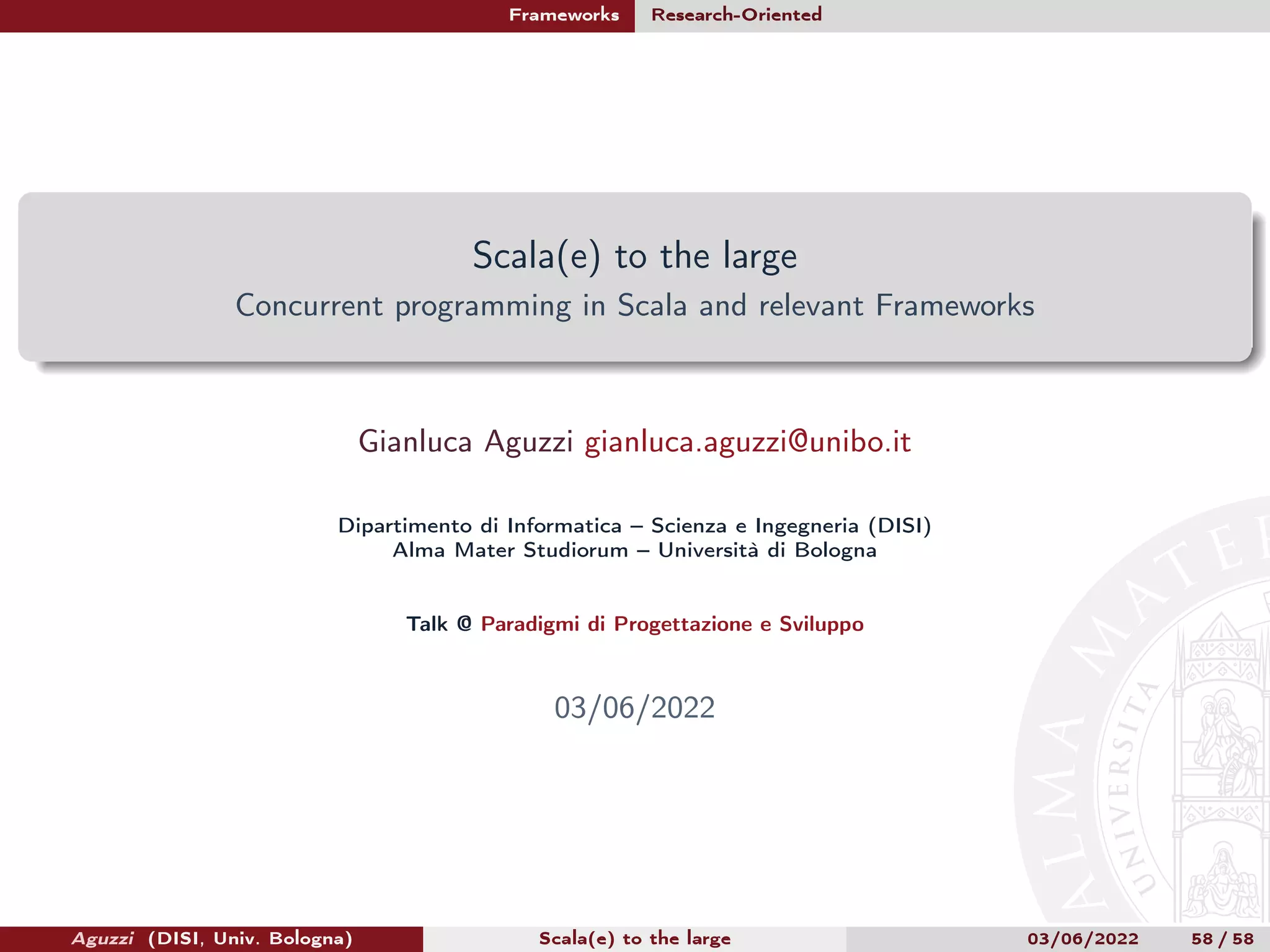
![References References I [1] Alvin Alexander. Functional programming, simplified : simple, step-by-step approach to learning functional programming. Boulder, Colo: Alvin Alexander, 2017. isbn: 1979788782. [2] Stephen Blackheath. Functional reactive programming. Shelter Island, NY: Manning Publications Co, 2016. isbn: 9781633430105. [3] Cats Effect · The pure asynchronous runtime for Scala. https://typelevel.org/cats-effect/. (Accessed on 06/03/2022). [4] cats effect documentation - Cerca con Google. https: //www.google.com/search?q=cats+effect+documentation&oq=cats+effect+ documentation&aqs=chrome..69i57.3488j0j4&sourceid=chrome&ie=UTF-8. (Accessed on 06/03/2022). [5] Documentation | Akka. https://akka.io/docs/. (Accessed on 06/03/2022). [6] HaskellWiki. Functional programming — HaskellWiki. [Online; accessed 31-May-2021]. 2020. url: https://wiki.haskell.org/index.php?title= Functional_programming&oldid=63198. [7] Bartosz Milewski. Category theory for programmers. Bartosz Milewski, 2019. isbn: 9780464243878. Aguzzi (DISI, Univ. Bologna) Scala(e) to the large 03/06/2022](https://image.slidesharecdn.com/scala-to-the-large-220921084504-42ce61ab/75/Scala-e-to-the-large-Concurrent-programming-in-Scala-and-relevant-Frameworks-59-2048.jpg)
![References References II [8] Monix Documentation. https://monix.io/docs/current/. (Accessed on 06/03/2022). [9] Overview - Spark 3.2.1 Documentation. https://spark.apache.org/docs/latest/. (Accessed on 06/03/2022). [10] ScaFi Aggregate Programming Toolkit - Home. https://scafi.github.io/. (Accessed on 06/03/2022). [11] ScalaLoci – A Programming Language for Distributed Applications. https://scala-loci.github.io/. (Accessed on 06/03/2022). [12] Gurnell Welsh. Scala with Cats. Bartosz Milewski, 2017. Aguzzi (DISI, Univ. Bologna) Scala(e) to the large 03/06/2022](https://image.slidesharecdn.com/scala-to-the-large-220921084504-42ce61ab/75/Scala-e-to-the-large-Concurrent-programming-in-Scala-and-relevant-Frameworks-60-2048.jpg)